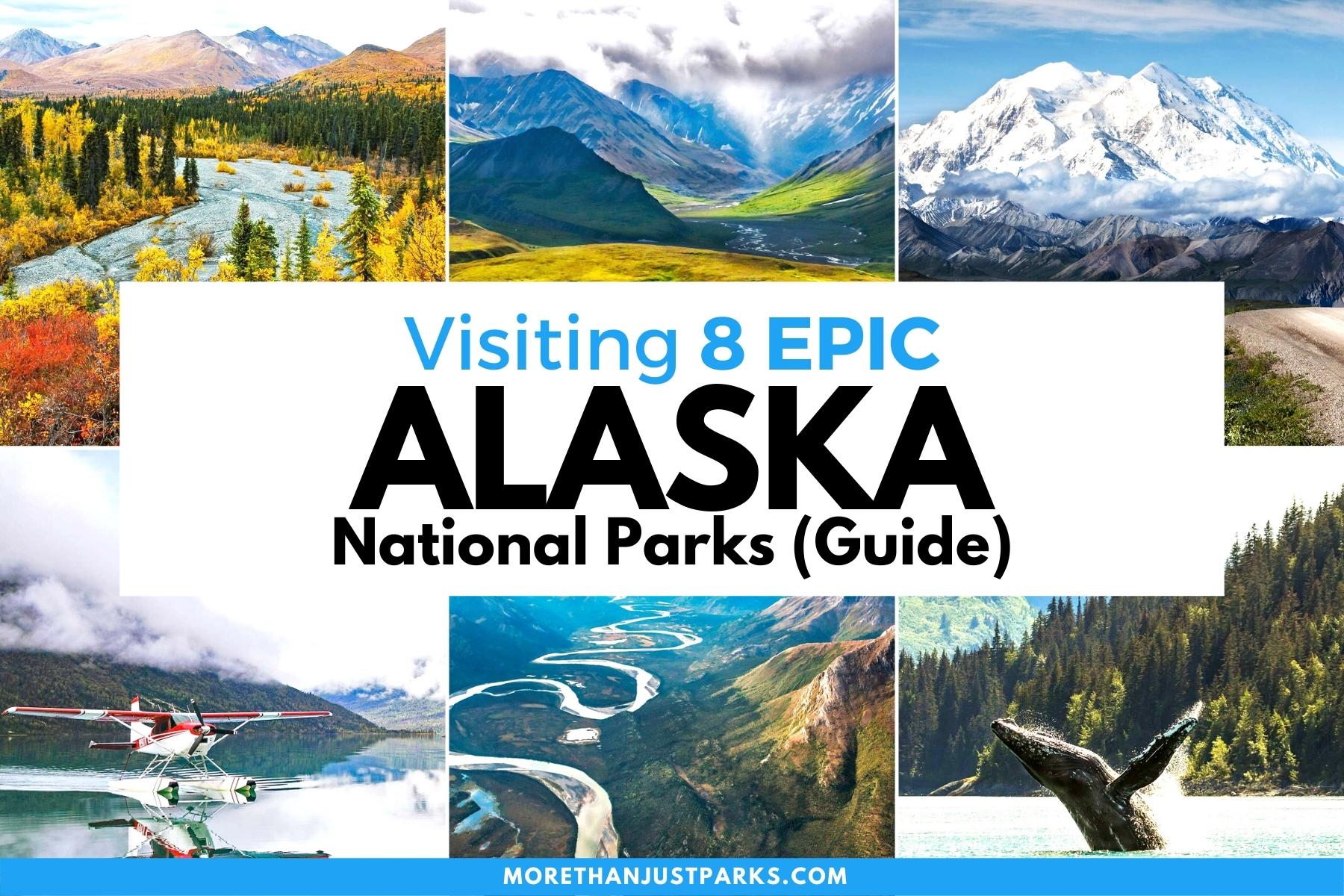
Article Overview: Alaska National Parks
Alaska is home to the most epic national parks on the planet with unimaginable sights and unfathomable vastness.
If Alaska’s National Parks comprised their own state, that state would be the 14th largest in the union, ahead of Utah (thank you, Jimmy Carter).
Alaska’s national parks feature some of the most breathtaking natural scenery on the planet including massive glaciers, jaw-dropping mountain ranges, immense herds of Caribou, grizzly bears, bald eagles, wild salmon, and so much more.
Before you go booking your flights we thought you should know exactly how to access each of these parks.
Whereas most of the other parks can be driven to, or at the very least accessed via a commercial airline, Alaska national parks are another ballgame altogether.
I’ve included a printable / downloadable version of this Alaska National Parks Map at the bottom of the article for anyone interested.
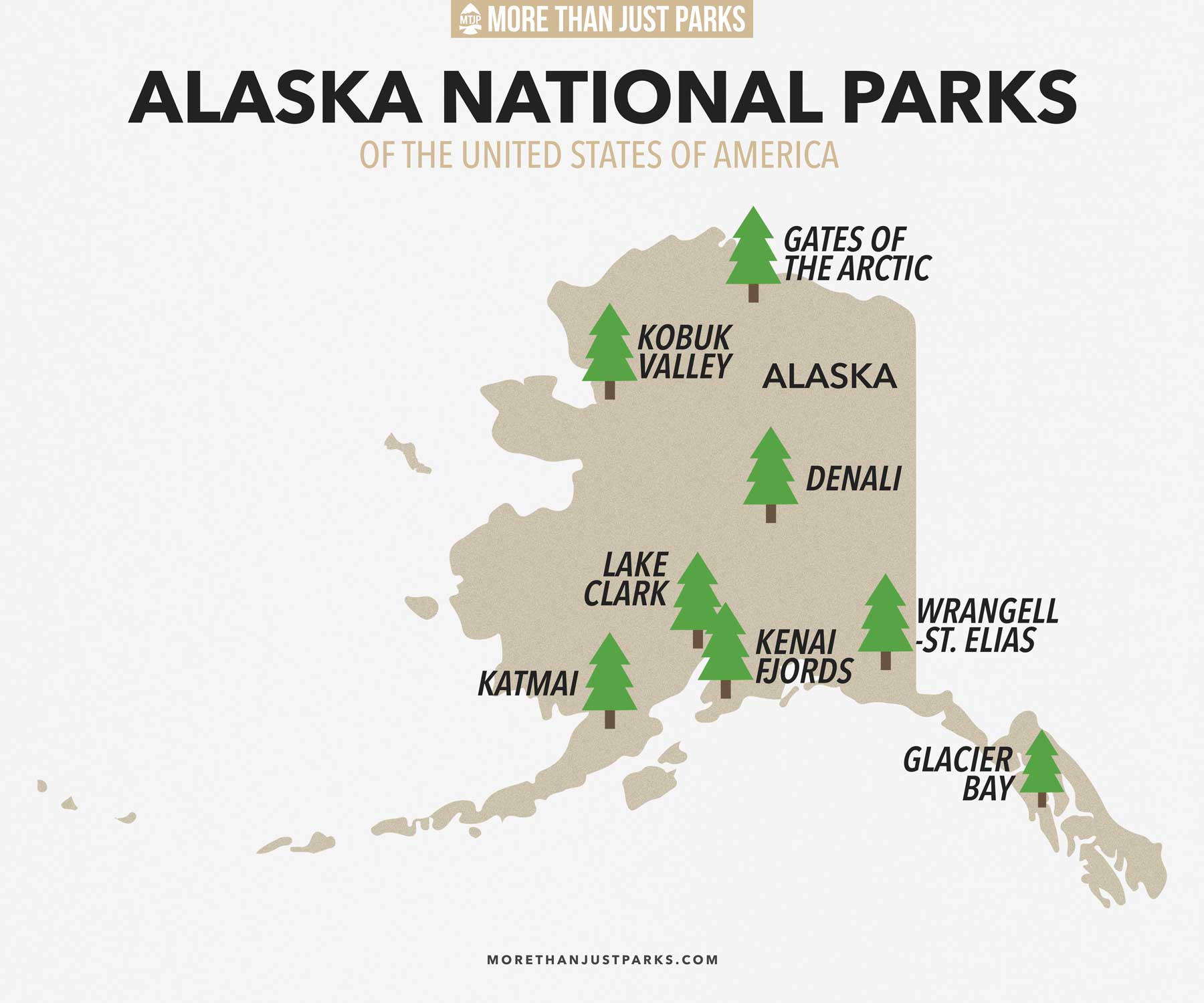
Alaska National Parks Overview
In this article we’ll cover:
- Planning an Alaska National Parks Trip
- Getting to Alaska’s National Parks
- Cost of Visiting Each Alaska National Park
- Which Alaska National Parks You Can Drive To
- Best Time to Visit Alaska’s National Parks
- Alaska National Parks Weather
- Guides to Each Alaska National Park
- and more
So, we’ve ranked all eight Alaska national parks from easiest to access to most difficult and detailed how exactly you can get to each one (and roughly how much that might cost).
We’ve also provided a bunch of helpful tips for planning your trip to an Alaska National Park.
Let’s get started!
Table of Contents: Best Alaska National Parks
Table Of Contents: Alaska National Parks
Things to Know Before You Visit an Alaska National Park
Bear Spray
If you’re visiting an Alaska National Parks there is automatically a much higher chance you’ll encounter a grizzly bear than parks in the lower 48. While 99% of folks don’t have to use it, it’s always better to be prepared with a can of bear spray.
Entrance Fees
$30 per vehicle OR if you plan to visit more National Parks within the next 12 months we suggest you go ahead and purchase the America the Beautiful Pass (which can be found at the entrance gates to most national parks). This pass gets you into all National Parks, Forests, Monuments, and more including 2,000 sites for free after a one time $79 fee.
Sunscreen
Use it. Lots of it. Especially this one which we never leave the house without because it plays nice with our dear friend, earth 🙂
Leave No Trace
We’re big fans of Leave No Trace, here at MTJP. Want to learn more? Read about the seven principals of Leave No Trace here.
Insect Repellent
In Alaska mosquitoes can be insane. Coastal parks are not *as* bad and it of course varies by season, but we highly recommend you carry around an Eco-Friendly Insect Repellent with you. Also worth considering are mosquito net hat, mosquito net pants, & mosquito net top cover.
Dogs
Dogs are not allowed on trails in most national parks due to their potentially disruptive presence with the natural ecosystem. The basic rule is they are allowed where cars can go so be sure to check before taking your pooch on your trip to the park!
Planning a Trip To Alaska’s National Parks
How Many National Parks Are In Alaska?
There are currently 8 national parks in Alaska which combine for 54 million acres of the most beautiful places on earth.
Alaska does have other national park service units.
These parks are largely wilderness and some are so remote they might as well be entirely wilderness (rather than a national park)… I’m looking at you Kobuk Valley and you, Gates of the Arctic.
There are also two stunningly beautiful national forests – the Chugach National Forest & the Tongass National Forest – which are also worth a visit.
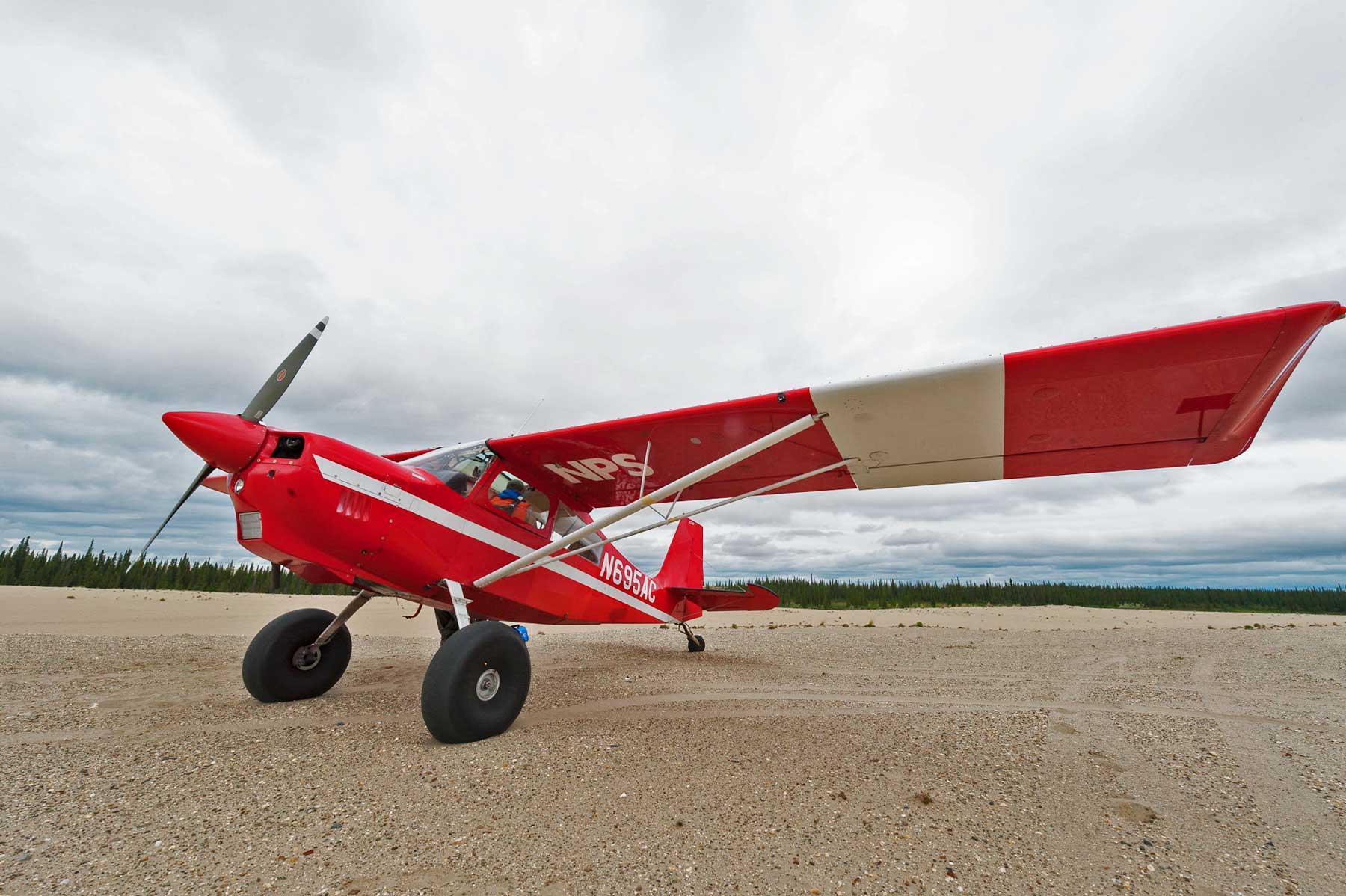
Which of Alaska’s National Parks Can You Drive To?
You can drive to 3 of Alaska’s 8 national parks. The Alaska national parks you can drive to are Denali National Park, Kenai Fjords National Park, and Wrangell St Elias National Park.
With that being said, driving is limited in these parks to relatively small sections – more on that below.
Denali National Park and Kenai Fjords National Park are both accessible by train and bus.
Kenai Fjords National Park & Glacier Bay National Park can be accessed by cruise ship and ferry.
The parks that are exclusively accessed by small planes are Lake Clark National Park, Gates of the Arctic National Park, Kobuk Valley National Park, and Katmai National Park.
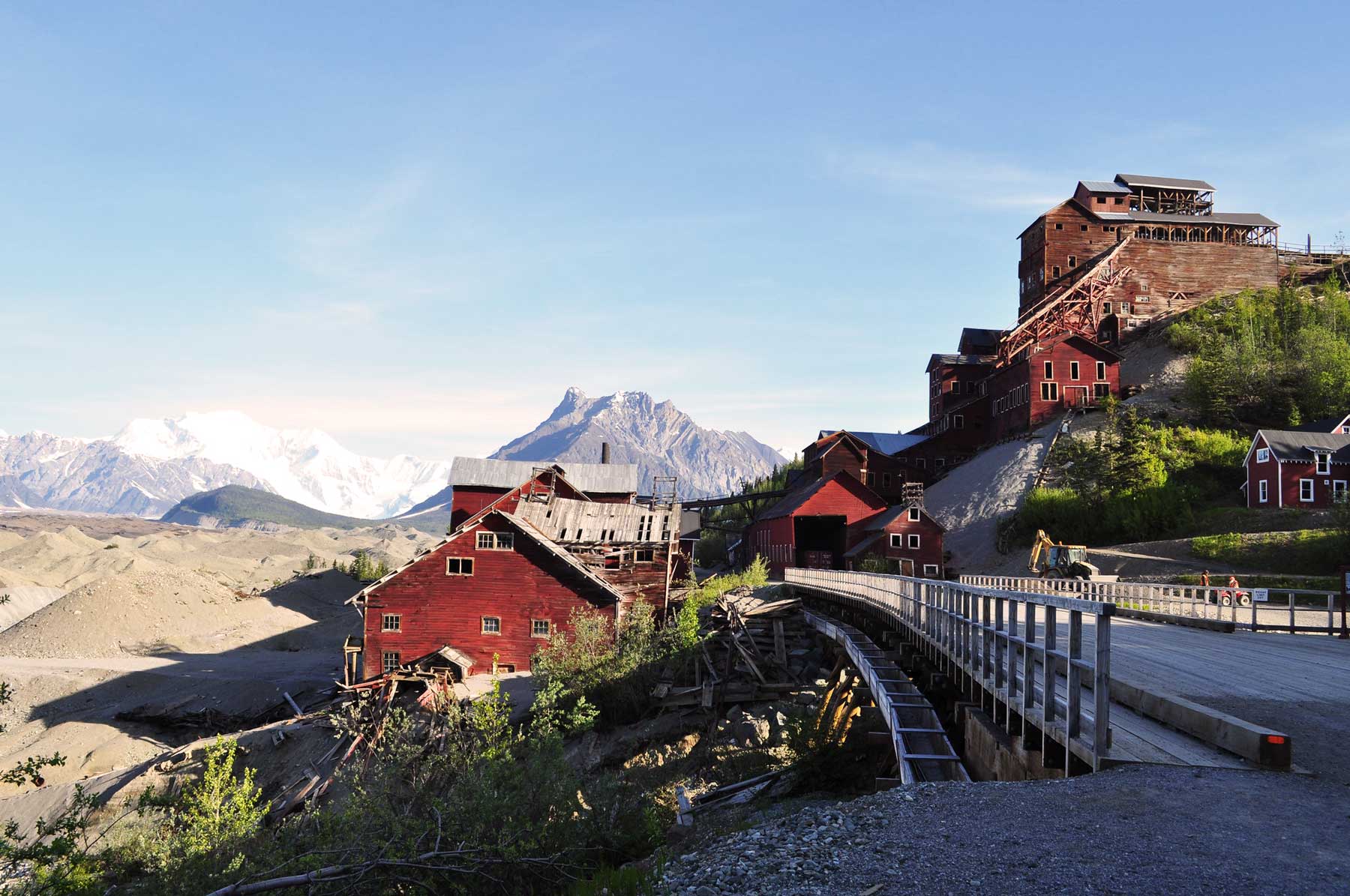
The Best Time to Visit Alaska’s National Parks
Choosing the right season to visit Alaska isn’t hard. With long days, less precipitation (but still precipitation), and actual sunshine, Summer is by far the best time to visit Alaska’s national parks.
We recommend planning your trip in July or August for the best chances at having clear days and nice weather.
Even in Summer, average high temperatures will range in the mid 60s to low 70s with lows in the 40s. Jackets are always a good idea here, especially rain jackets.
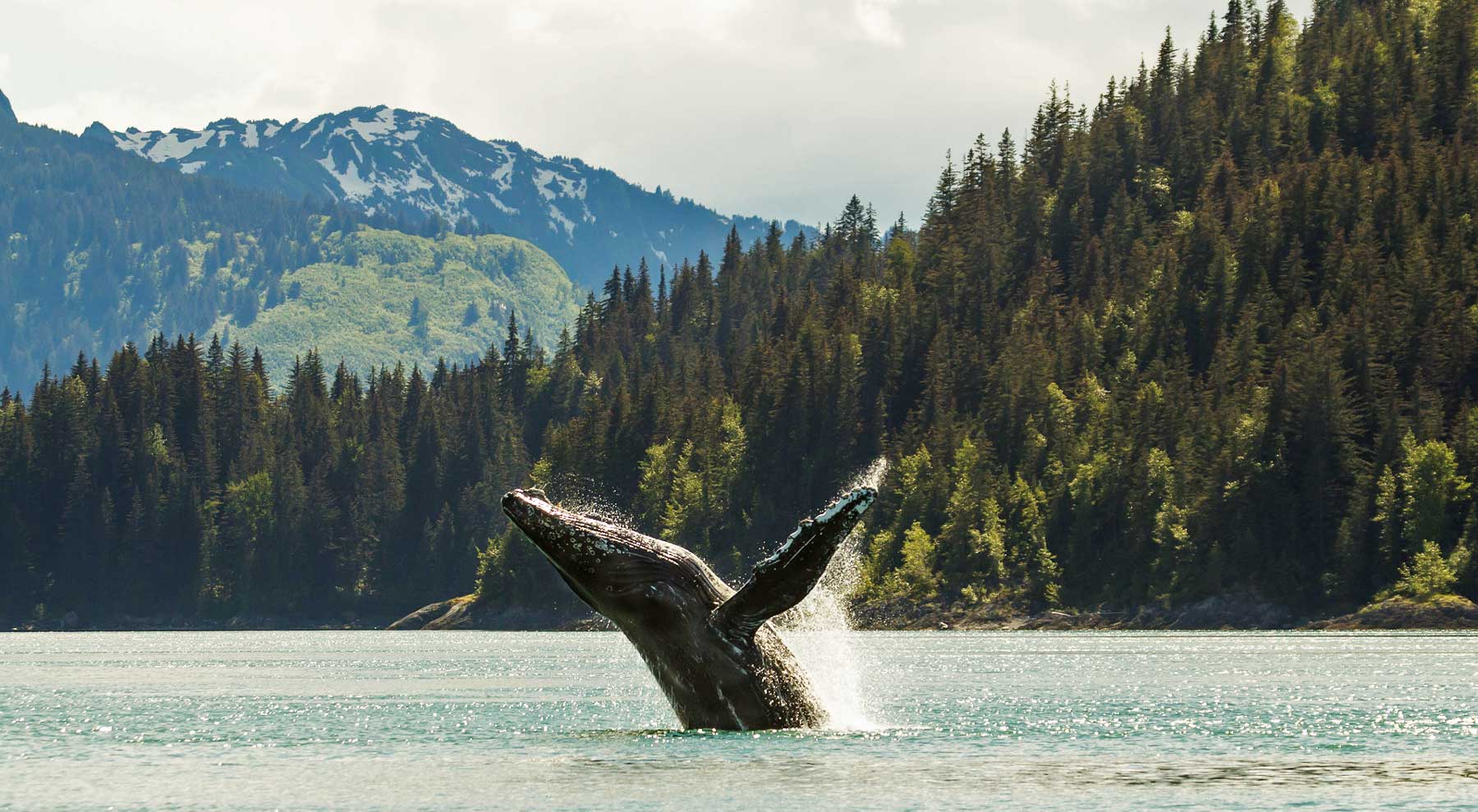
Alaska National Park Weather Forecasts
Weather forecasts are not to be relied upon in Alaska’s national parks as the unpredictability of weather systems is tremendous.
Flights on small, fixed-wing aircraft into the parks are routinely cancelled at the last minute as well as ferry rides. The name of the game is being flexible with your plans and taking rough weather in stride.
We once planned a two week trip to Alaska in late August and did not see blue sky a single day we were there. Was it still worth it? Yes.
Always be prepared for rain regardless of the forecast.
Alaska National Parks
Alaska’s National Parks ranked from the easiest to access to the most difficult.
Top 5 Alaska National Parks to Visit
1. Kenai Fjords National Park, Alaska
Score: 38/50
- Accessibility – 4.5/10
- Recreation – 7.5/10
- Crowds – 10/10
- Amenities – 7/10
- Scenery – 9/10

About Kenai Fjords National Park
Kenai Fjords is the most accessible of Alaska’s national parks. Unlike most other national parks in Alaska, there is actual driving in the park (however limited) that allows access to hiking trails.
At Kenai Fjords you go on epic hikes, take once in a lifetime boat tours, see massive glaciers, spot stunning wildlife, and more.
There’s also regular boat tours out of Seward that take visitors by many of the most breathtaking areas and sites.
Couple that with it’s close proximity to the major city of Anchorage with regular commercial flights and we’ve got ourselves a real winner.
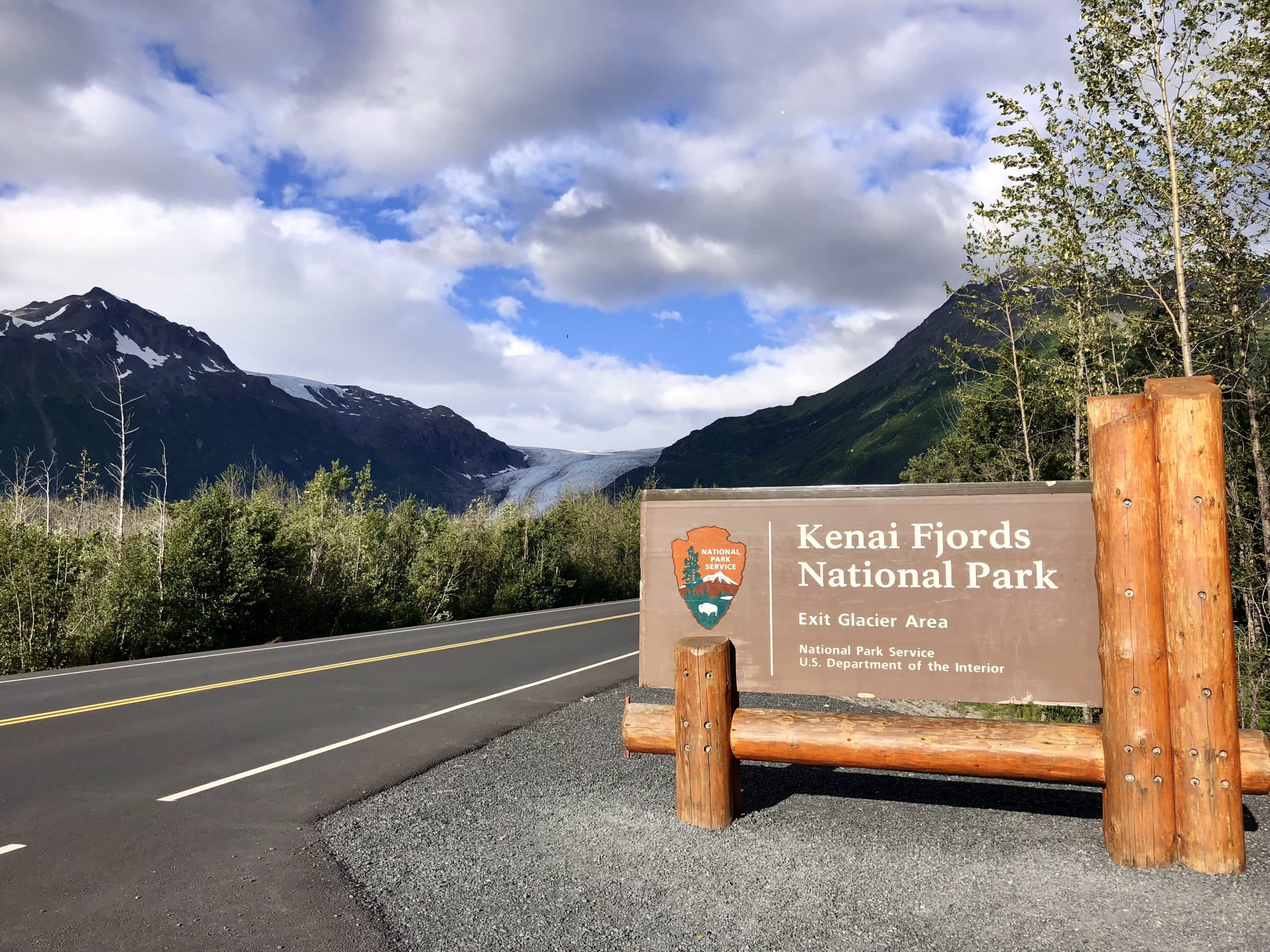
Getting to Kenai Fjords National Park
Good news here folks! Getting to Kenai Fjords National Park is easy. We recommend flying into Anchorage and driving to the park.
Entrance Fees – Kenai Fjords
Good news! There are no entrance fees to get into Kenai Fjords National Park. Visitors may enter the park completely free of charge.
Can You Drive to Kenai Fjords National Park?
Yes! From Ted Stevens International Airport in Anchorage the drive (quite a scenic one) to Exit Glacier (the park’s main driving attraction) is just 2.5 hours.
There is a visitors center located just south of the park’s driving entrance in Seward.
Bus & Train to Kenai Fjords National Park
You can also take a bus from Anchorage to Seward (see this link) as well as a train via the scenic Alaska Railroad (see this link). Seward is the closest city to the park and consider the gateway to Kenai Fjords.
Kenai Fjords National Park Ferry & Tours
There are two main ferry vendors for Kenai Fjords offering a couple of different tour options – Alaska Collection and Major Marine.
There are several different tours available that vary in destination & length. The shortest trips are about 3.5 hours and the longest are 8.5 hours.
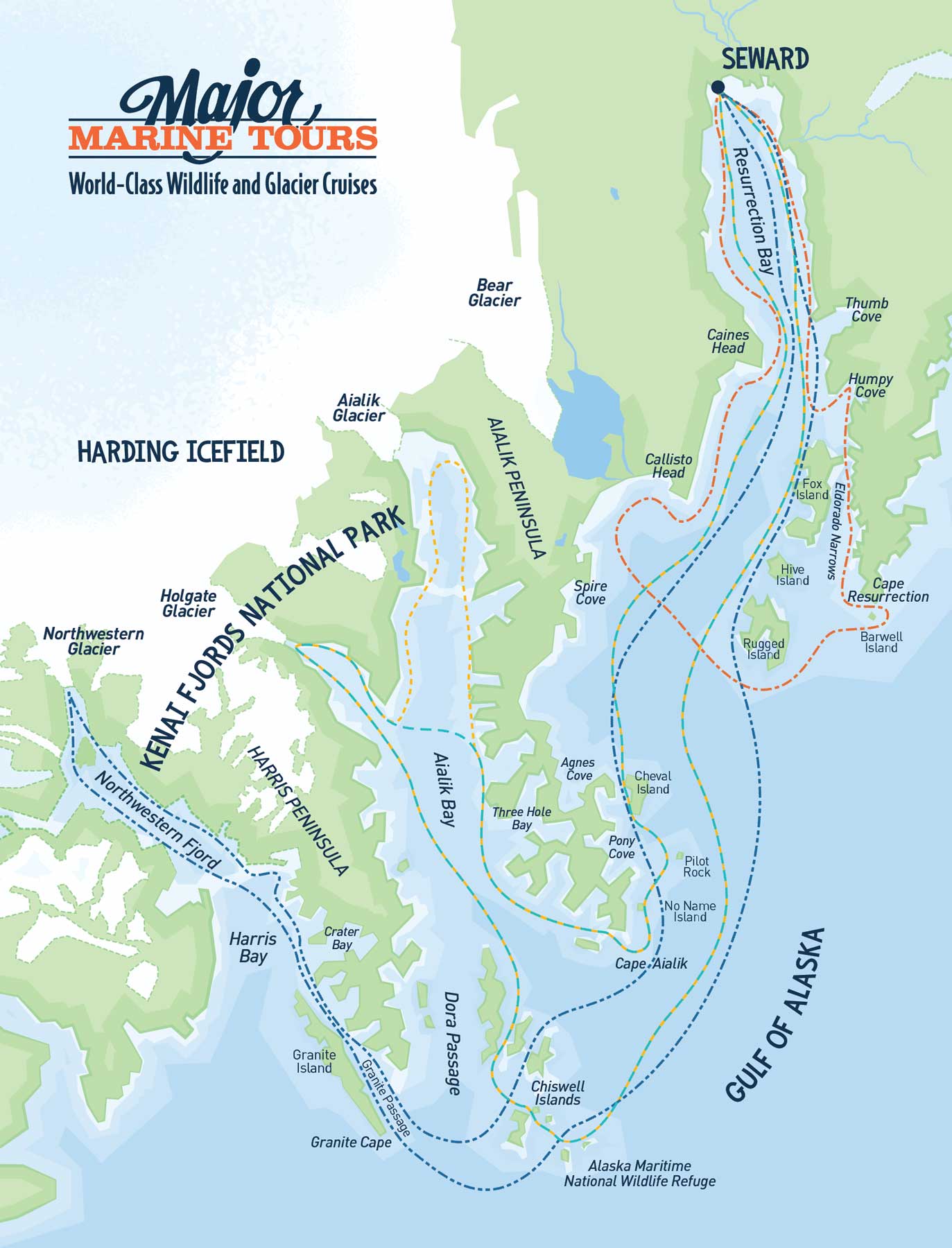
Destinations & sites include Resurrection Bay, Fox Island, Orca Explorers, Wildlife Cruises, Holgate Glacier, Aialik Glacier, Northwestern Glacier, and more.
Prices per person vary but the average for adults are around $180 and kids are around $80.
Best Time To Visit Kenai Fjords National Park – Seasons & Weather
Like all of Alaska’s National Parks, the best time to visit Kenai Fjords National Park is during Summer.
We recommend the months of July & August for the best chances for clear days.
Best Things to Do – Kenai Fjords National Park
- Fishing – Here’s a great guide on fishing in southeast Alaska.
- Hike The Harding Ice Field Trail – This is the most popular hike in Kenai Fjords National Park. The entire hike is 8 miles round trip and is considered strenuous as there is over 4000ft of elevation gain.
- See Exit Glacier – Alternatively you can do the shorter route up to exit glacier which is an easy hike that gives hikers great, up close views of a live glacier!
- Go on a scenic ferry tour – Take a day to tour the park the best way, via ferry! This is the best way to see the park as you cover a lot of ground and see some incredible wildlife and scenery up close.
- Go Kayaking – Kayaking is available in Resurrection Bay via water taxis (for a backcountry trip) or via a guided tour from Seward.
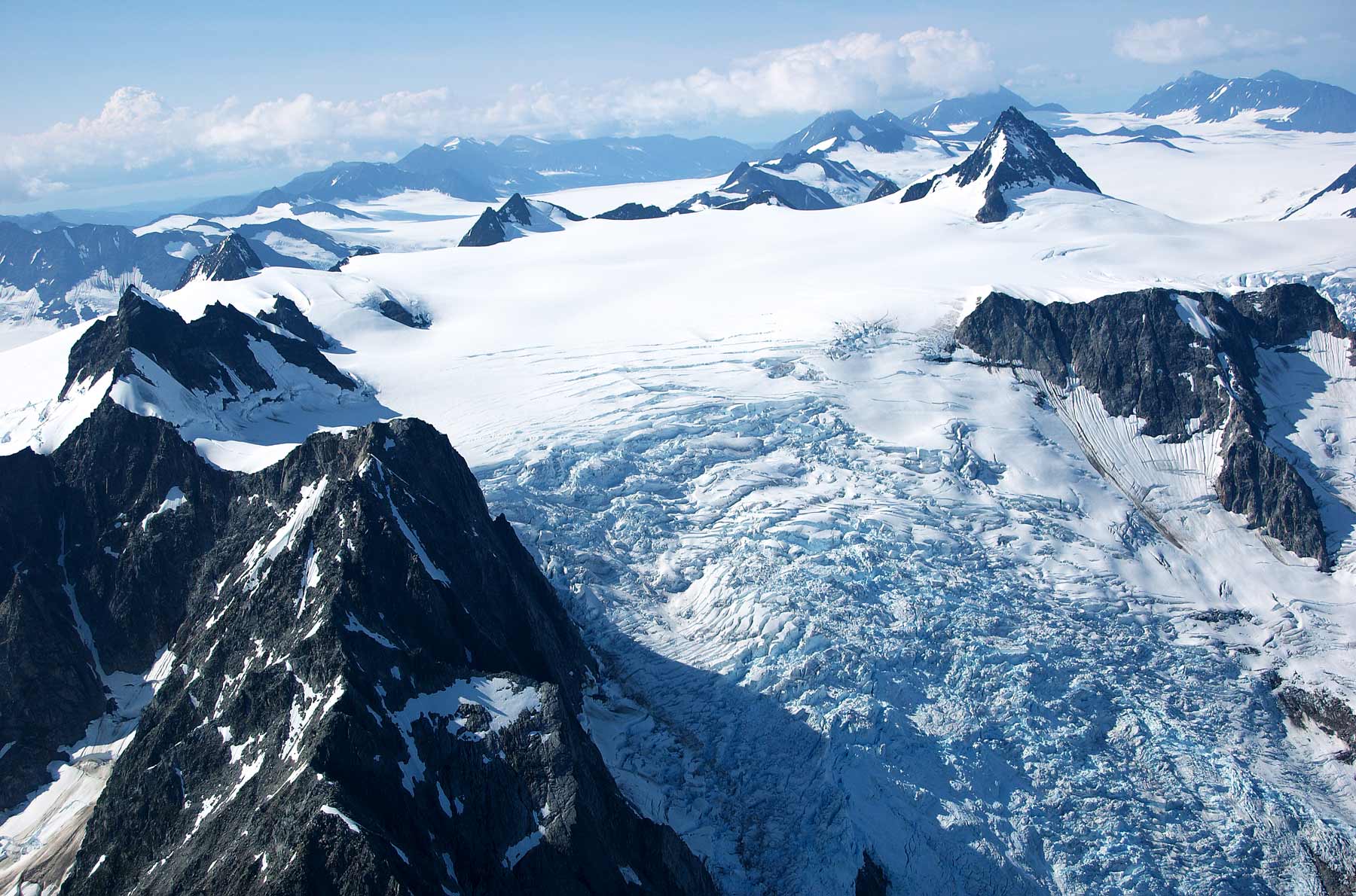
Where to Stay – Kenai Fjords Lodging & Camping
Camping in Kenai Fjords
Exit Glacier Campground – There is only one developed campground in Kenai Fjords National Park located next to Exit Glacier. The campground has 12 walk-in, tent-only sites available on a first-come, first-served basis.
Backcountry Camping – Most visitors who camp in the backcountry in Kenai Fjords do so via kayak along the coast.
There are a number of other backcountry options (even on the Harding icefield). Anyone traveling in the backcountry should be especially bear-aware and consider going with a guide.
Public Use Cabins
There are two public-use cabins located within Kenai Fjords National Park that are reservable during Summer and accessible by water only – Holgate Cabin and Ailiak Cabin.
Once the Exit Glacier road closes for winter another cabin becomes available for public use – the Willow Cabin.
Lodges & Hotels
Kenai Fjords Glacier Lodge – There is only one lodge located on the Kenai Fjords Coast. It is accessible by boat exclusively.
Alternatively there are several lodges and hotels in the Seward area that start at around $150/night and range upwards from there.
2. Denali National Park, Alaska
Resources: Facts
Score: 37
- Accessibility – 6/10
- Recreation – 8/10
- Crowds – 9/10
- Amenities – 5/10
- Scenery – 9.5/10
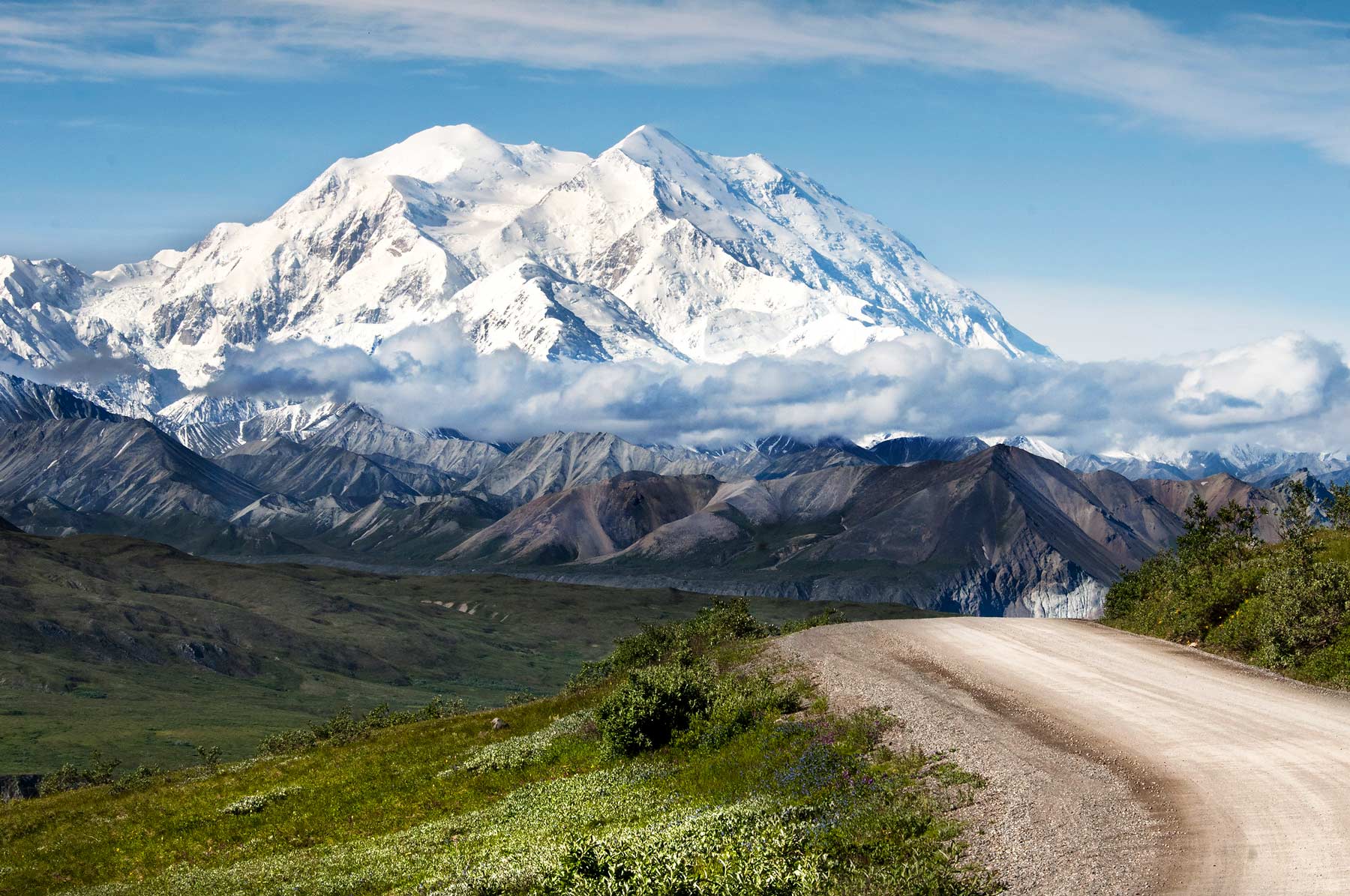
About Denali National Park
Alaska’s flagship national park named for its tallest mountain which happens to be the highest peak in North America, Denali is on every park-goers bucket list. The breadth of this mountain is hard to appreciate and so is the size of the park itself at 6.1 million acres.
Denali also happens to be one of the most accessible Alaskan national parks with limited driving access, bus access that gets you further, visitor center, campgrounds, and the famous car lottery.
Getting to Denali National Park
Great news here, folks! Denali National Park is one of three Alaska national parks that folks can drive to. We recommend flying into Fairbanks and driving to the park.
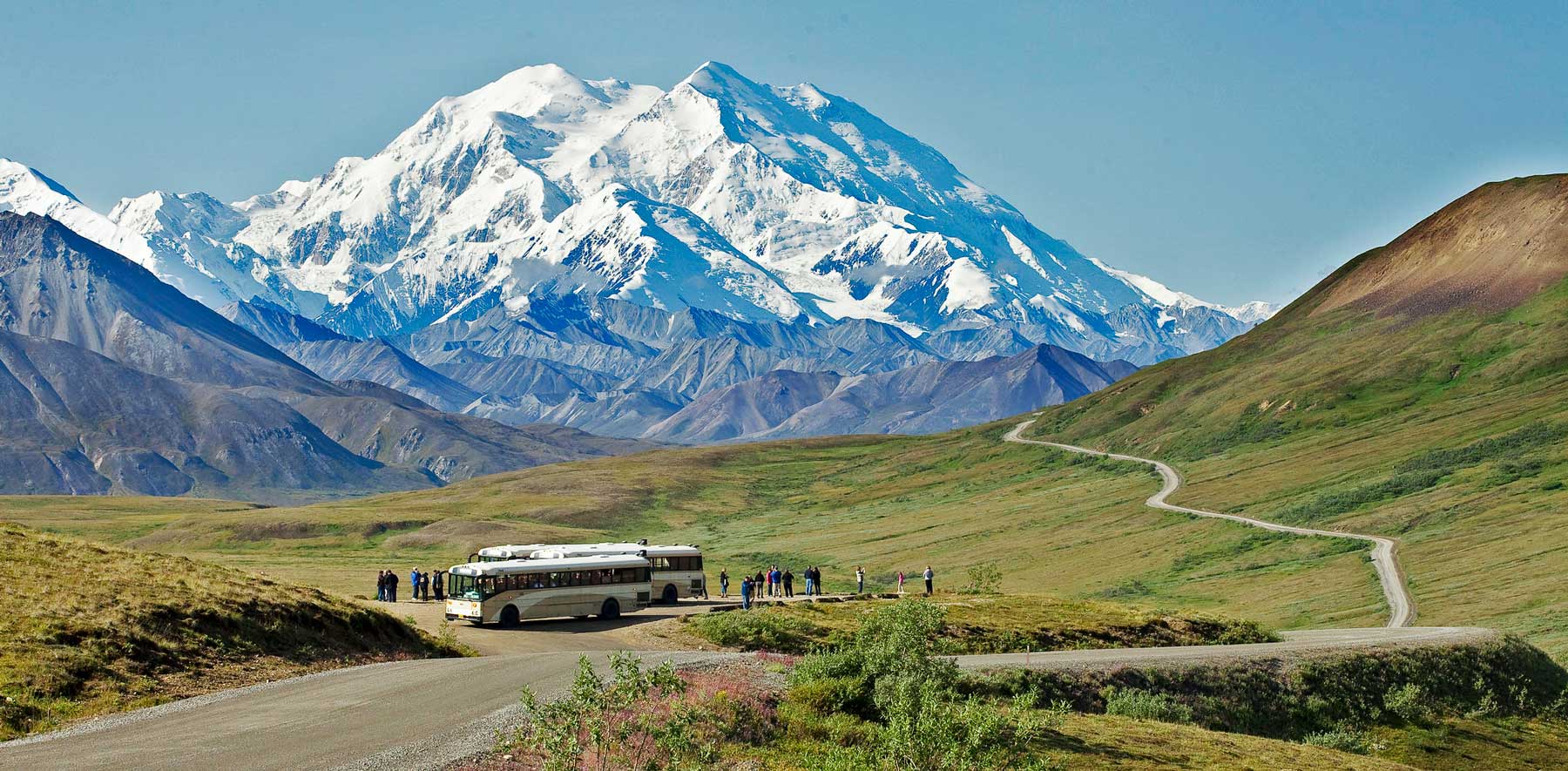
Entrance Fees – Denali National Park
Unlike most national parks which charge per vehicle, Denali National Park charges $15 per person for admission. Alternatively you can opt to purchase the Denali Annual Pass online (which covers up to 4 adults) for $45 dollars.
Train to Denali National Park
Taking the train to Denali National Park is another great and scenic way to get to the park via the Alaska Railroad’s Denali Star line.
From Fairbanks the ride is 4 hours long and runs around $80/adult and $40/child each way.
From Anchorage to Denali the ride is roughly 7.5 hours long and the rates are about $180/adult & $90/child each way.
For more fare & schedule information visit the Alaska Railroad’s Denali page.
Can you Drive to Denali National Park?
Yes, you can drive to Denali National Park! From Fairbanks International Airport the drive is 2 hours southeast to the Denali National Park Visitors Center.
From Anchorage, the park entrance to Denali is about 4 hours north.
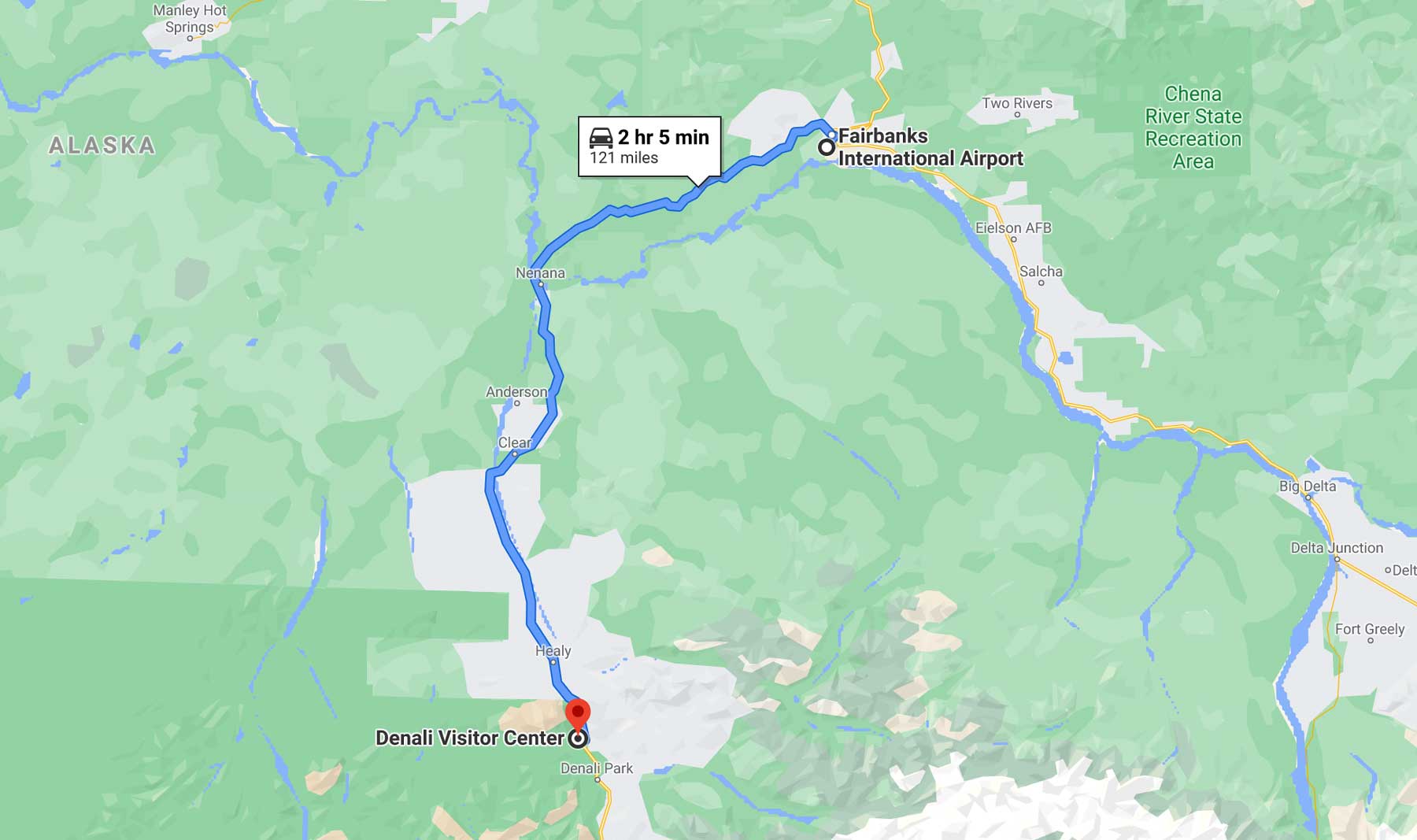
Denali National Park Road
While the Denali National Park Road is 92 miles long, most visitors are restricted to the first 15 miles in their own private vehicles (to a point called Savage River).
The park has instituted these restrictions to limit the overall impact of cars on the natural ecosystem. The rest of the drive is accessible via bus & the Denali National Park Road Lottery (see below).
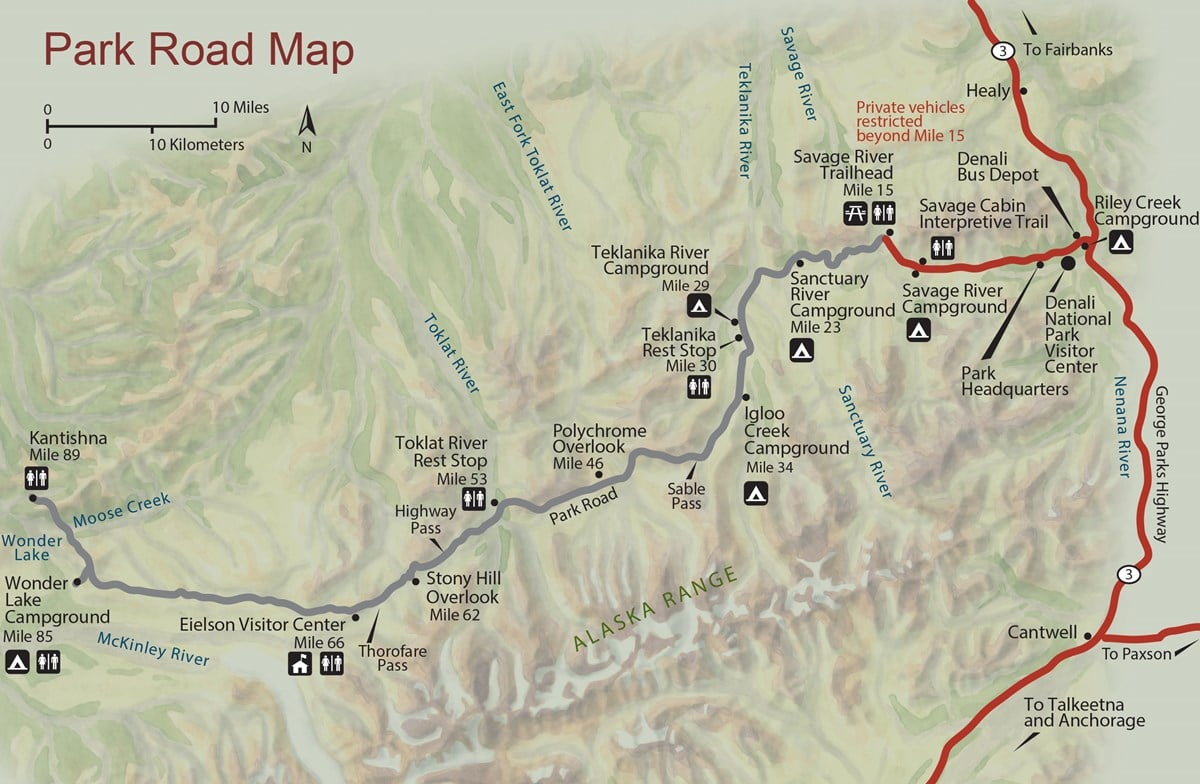
Denali National Park Bus
Denali National Park offers a host of great bus options to tour Alaska’s flagship national park park including both free and paid options.
The paid options include a narrated tour with guide and are not operated by the National Park Service and range in price from $100 – $240 for adults and $40 – $100 for kids.
The non-narrated transit bus is a cheaper option ($50 – $60 per person / kids ride free) designed to get people around the park and is operated by a park concessionaire.
Reservations may be made online via the park’s website.
Bus rides vary in length depending on which kind of tour you select or how far you would like to go into the park.
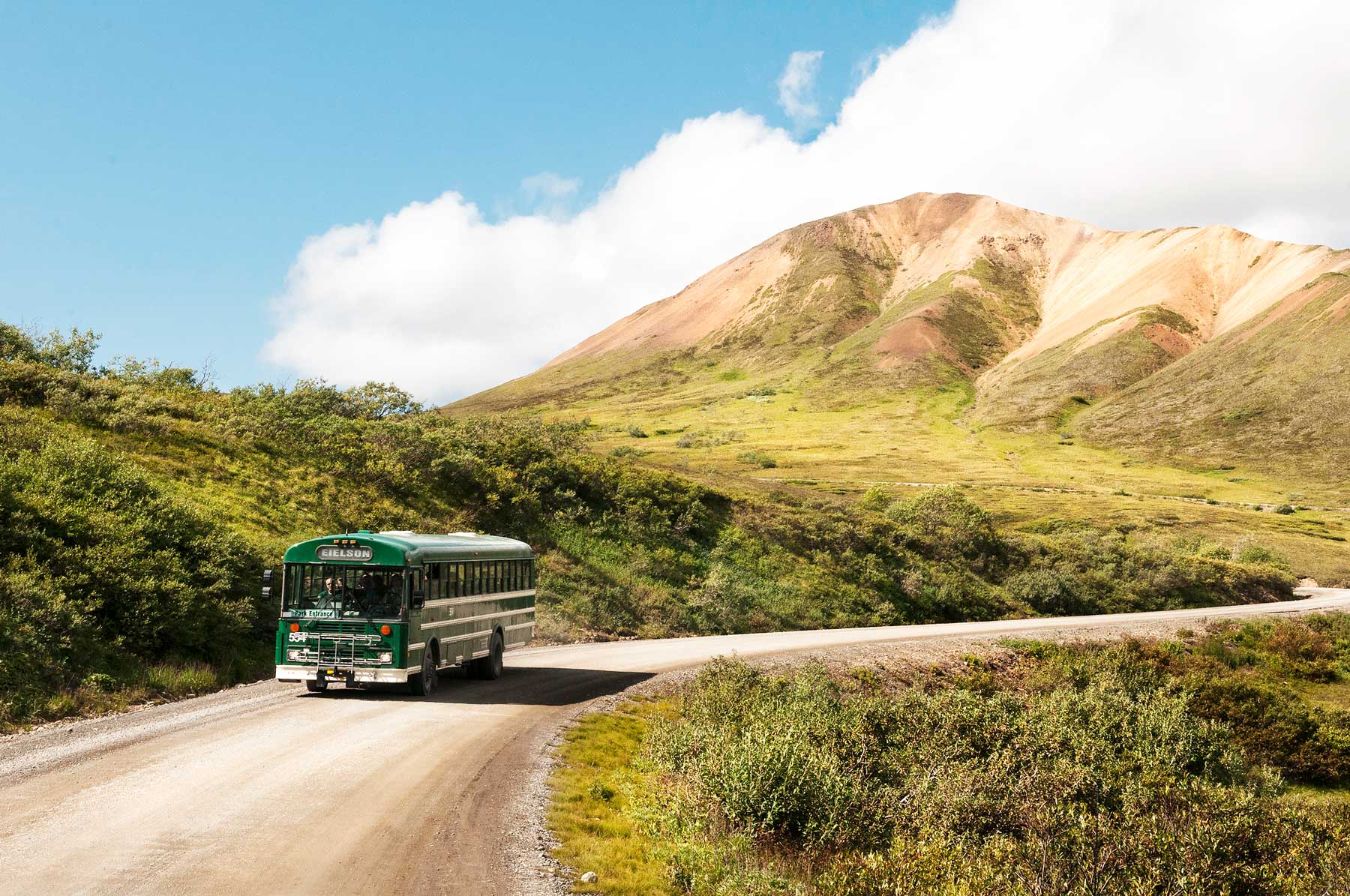
The shortest tours are around 4.5 hours long and the longest is 12 hours (going to the last stop on the Denali Road and back).
Make sure to pack plenty of food & water for your trip into the park as there are no conveniences available past the visitors center.
The Denali National Park Road Lottery
Winners of this Denali “golden ticket” get the ability to drive their own vehicles deep into the park via the Denali Road.
Every September the National Park Service hosts a 4 day event known as the road lottery.
For more details visit the park service page with rules and application options.
Cycling & Biking in Denali
Another great way to see Denali National Park is via a bicycle. Both regular bicycles and e-bikes are allowed and governed by the same rules.
While motor vehicles are restricted to the first 15 miles of the Denali Park Road, bicycles are allowed on all 92 miles.
Bike camping has become more popular as a result of this in Denali National Park as folks can saddle their bikes with the camping gear and hit the road.
Bikers can start at the beginning of the road or take the bus to a specific point before hopping off and beginning their journey.
When is the Best Time to Visit Denali National Park?
The best season to visit Denali National Park is in the summer when days are longer and weather is more cooperative.
Summer sees more sunny days in the park which is great for those of us keen on seeing that massive mountain’s peak.
With that being said, the vast majority of visitors to this Alaska national park do not get a chance to see the Denali’s peak due to weather conditions.
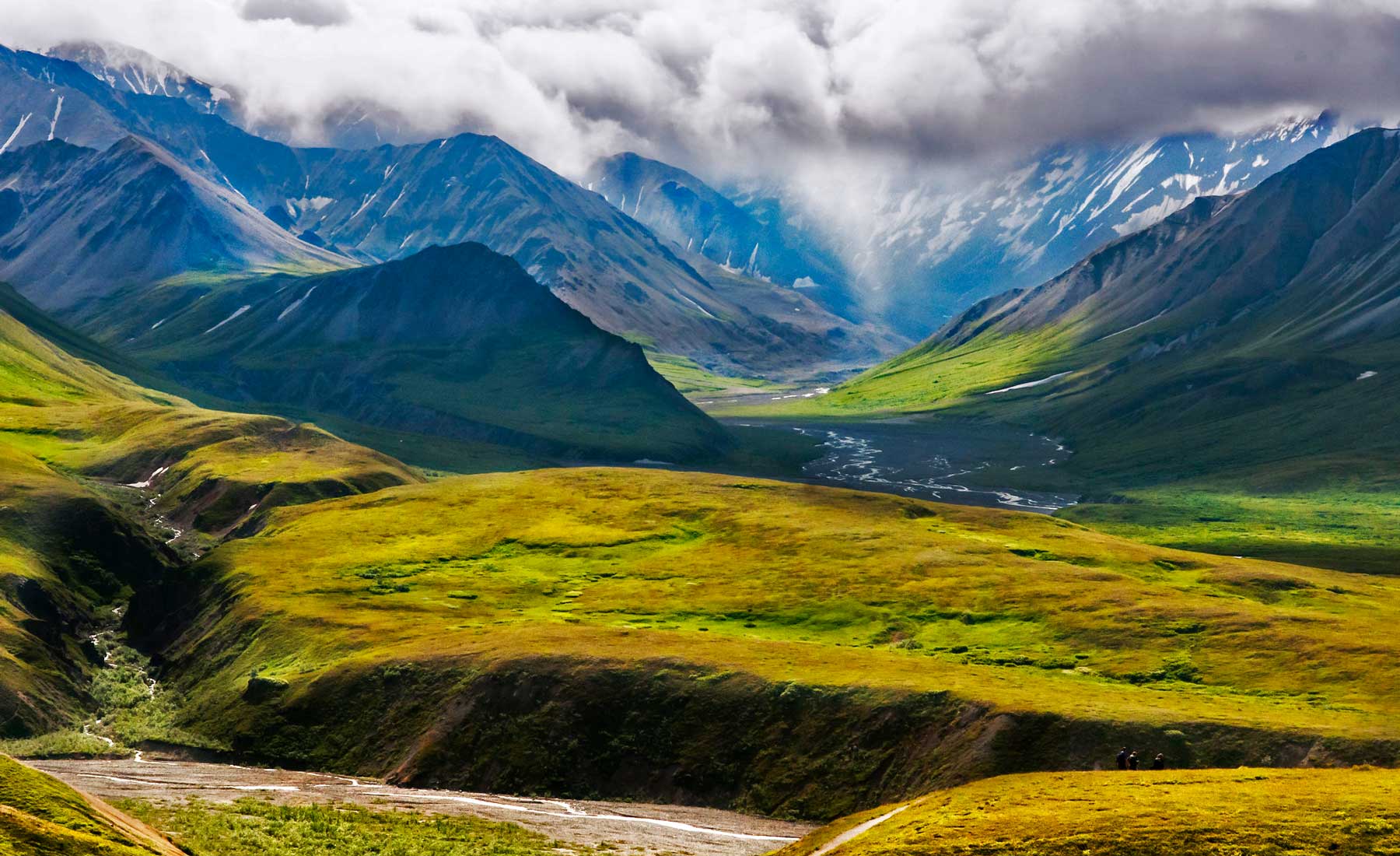
Best Month to Visit Denali
The best month to visit Denali is August due to the chances for good weather and somewhat less mosquitoes than July. Sunshine is most abundant during the month of August in Denali National Park.
Best Things to Do Denali National Park – Highlights
- Bus Tour – Take the bus deep into the park and experience America’s greatest frontier up close and personal.
- Bike Tour – Rent a bike and take it past where the private cars can go experiencing all of the park’s greatest wonders in the open air.
- Hike the Savage Alpine Trail – If you’re feeling adventurous then we highly recommend you hike the Savage Alpine Trail (8miles RT / 1500ft elevation gain). This hike is widely considered one of the best hikes in the park and is accessible via the Savage River area.
- Wildlife – Denali is home to a wide array of apex predators and unbelievable wildlife including grizzly bears, bald eagles, caribou, porcupines, and more.
- Camping – Take the bus to a campsite and spend the night in Alaska’s flagship national park on a bucket list experience.
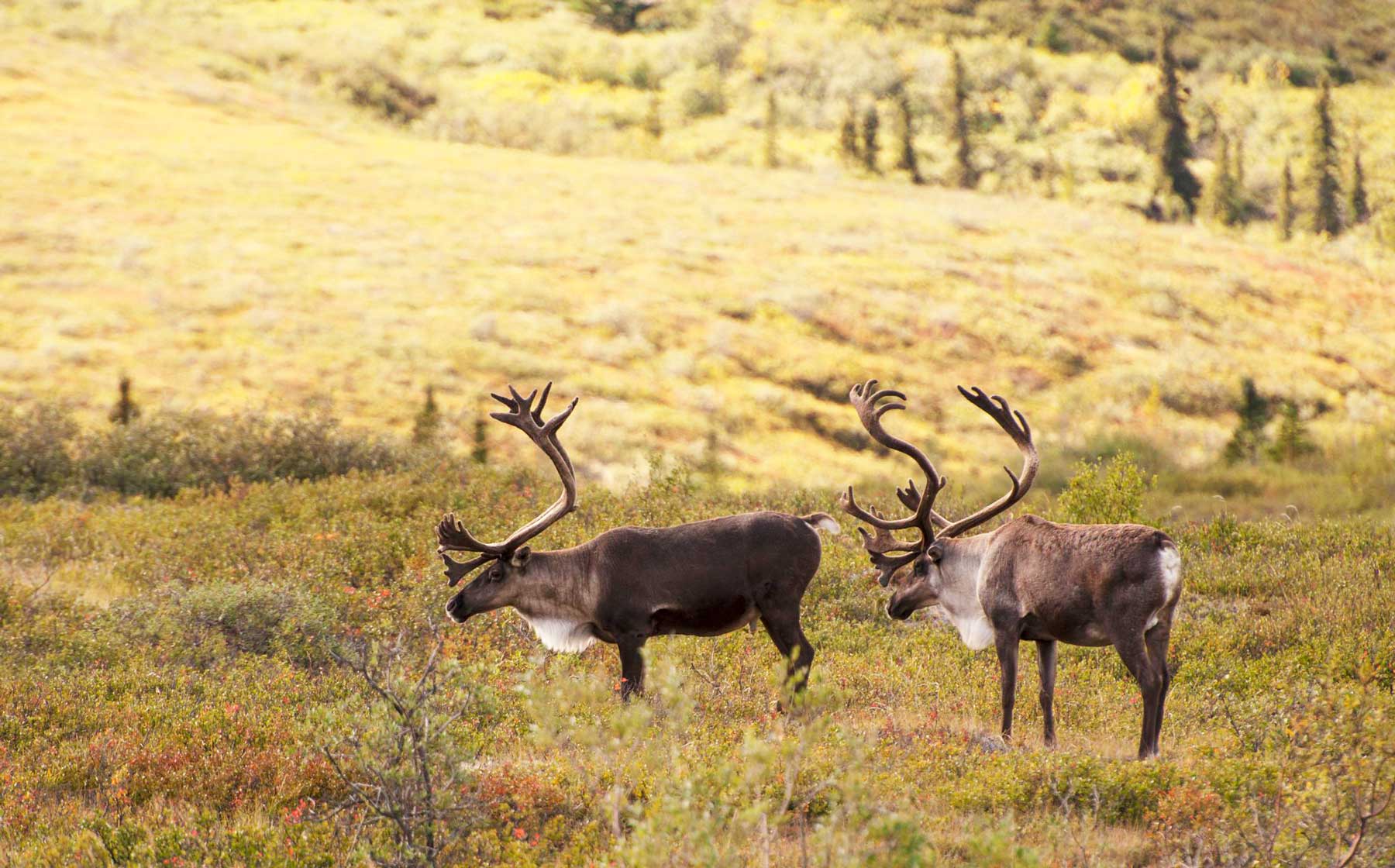
Camping in Denali National Park
Denali National Park is home to 6 developed campgrounds that can be accessed by the main park road.
Reservations are not required ahead of time for Denali campgrounds but are encouraged as you may find limited. All campgrounds are open Summer only with the exception of Riley Creek.
Campground fees range from $12 – $27 per night. Camping is free in winter for those who dare.
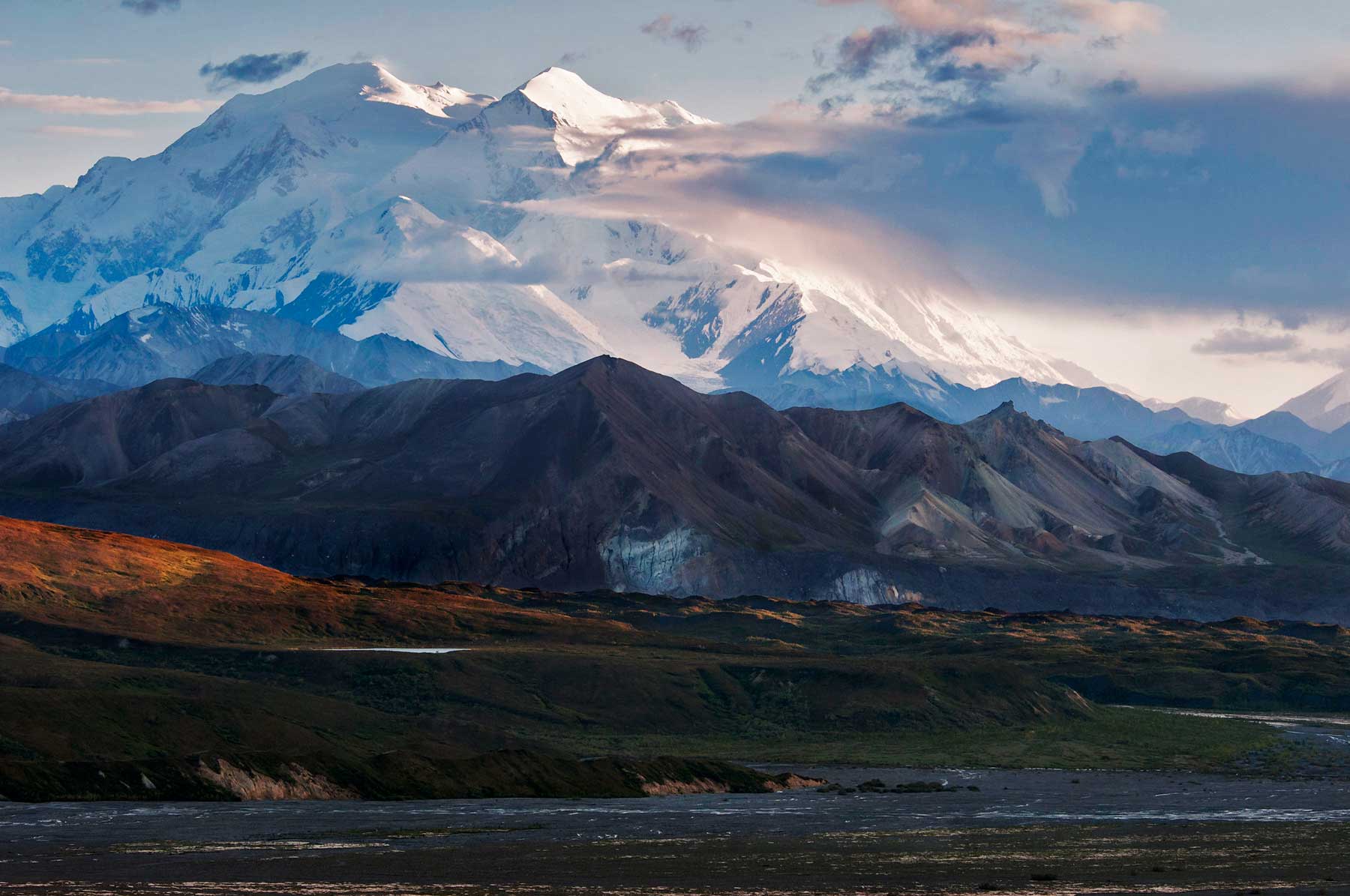
Denali National Park Campgrounds
- Riley Creek Campground (located at mile .25)
- Savage River Campground (located at mile 14)
- Sanctuary River Campground (located at mile 22)
- Teklanika River Campground (located at mile 29)
- Igloo Creek Campground (located at mile 35)
- Wonder Lake Campground (located at mile 85)
Denali is home to some epic backcountry camping adventures for those with For more Denali National Park camping information visit the park service’s website.
Denali Hotels & Lodges
While Denali National Park has no official park lodges, there are still some epic lodging options most of which come with pretty epic price tags.
We recommend reserving your accommodations as early in advance of your trip as possible as they tend to fill up quite a ways out.
Most folks stay outside of the park but there are four options inside the park boundaries but on privately owned land. All of these options are located at the end of the main park road.
3. Wrangell St. Elias National Park, Alaska
Score: 37
- Accessibility – 6/10
- Recreation – 8/10
- Crowds – 9/10
- Amenities – 5/10
- Scenery – 9.5/10
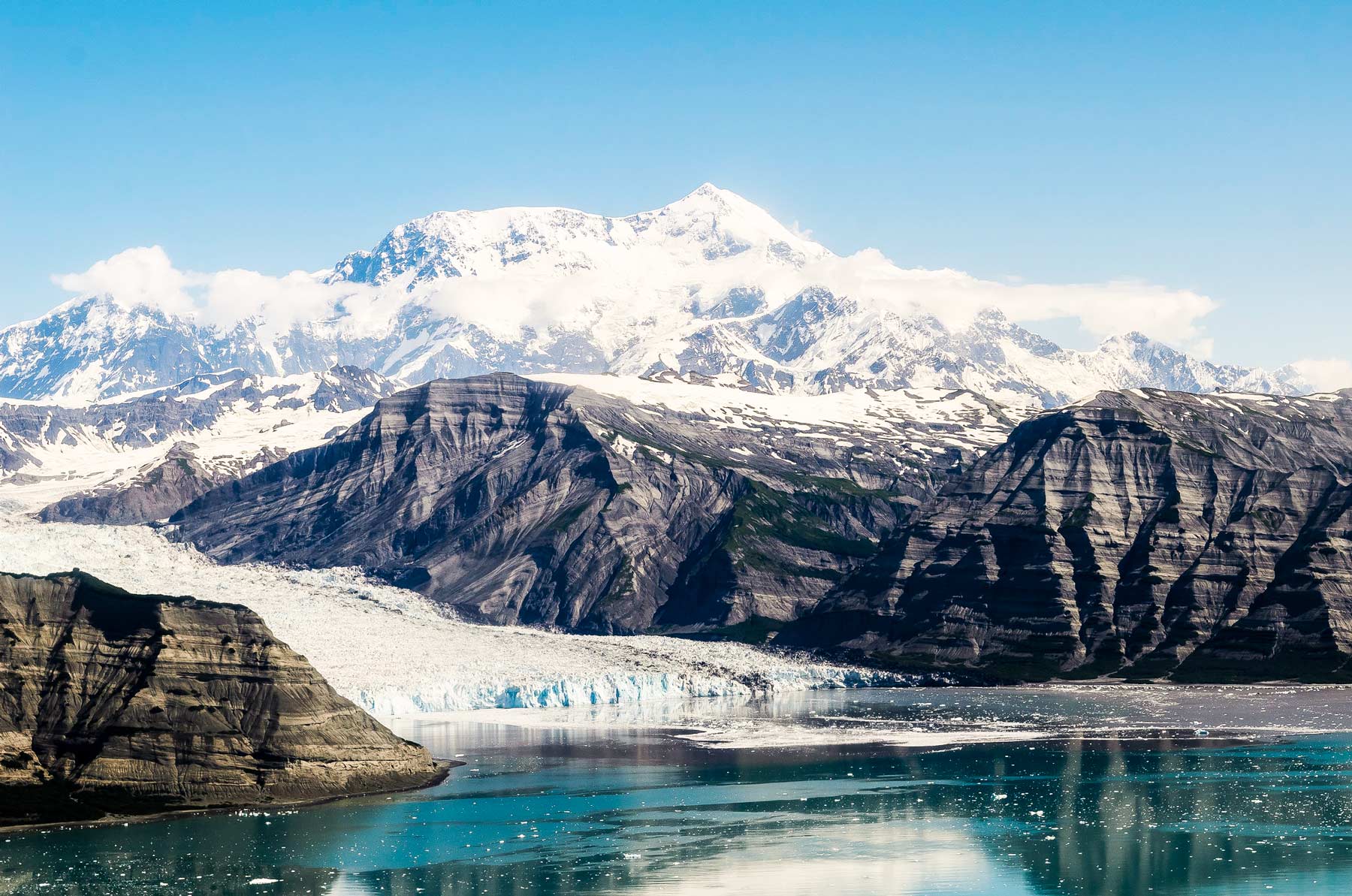
About Wrangell St. Elias National Park
As one of the more accessible Alaska national parks, Wrangell makes it into our top 20 US national parks for that reason alone.
Wrangell is an Alaska national park full of superlatives and a world unto itself. It is a park of otherworldly and seemingly impossible landscapes.
The difference at Wrangell vs some of Alaska’s national parks is that you can take a car and drive to some of them.
Wrangell St. Elias National Park is the largest in the US at over 13 million acres. The park features 9 of the 16 tallest mountain peaks in the country.
If Wrangell were a state, it would be larger than Connecticut, Delaware, and Rhode Island.
Getting to Wrangell St. Elias National Park
Hooray! If you’re hoping to be able to add Wrangell St. Elias National Park to some sort of Alaska National Park Road Trip, you’re in luck!
As one of three Alaska National Parks that visitors can drive to, Wrangell ranks among the most accessible. With that being said, there are three main ways to access the park – car, shuttle, and plane.
Entrance Fees – Wrangell St. Elias National Park
There are no entrance fees to access Wrangell St. Elias National Park which makes it another one of Alaska’s National Parks visitors can access free of charge (if you don’t count all the money it costs to get there!).
Can You Drive to Wrangell St. Elias National Park?
If you were asking the old Alaska question of “can I drive to Wrangell St. Elias National Park?” the answer is yes!
The drive to Wrangell St. Elias National Park (Kennecot) from Anchorage (the closest city with a major airport) is nearly 7 hours long, so buckle in and pack lots of snacks & drinks!

Bus & Shuttle to Wrangell St. Elias National Park
If you don’t want to do the driving to the park yourself there are bus options from Anchorage to Wrangell St. Elias National Park.
The going rate from Anchorage to Glenallen (3 hours) is $60 – $70 per person each way on Interior Alaska Bus Line or Soaring Eagle Transit. From Glenallen to McCarthy takes about 3 hours and will run you another $90 each way via Kennecot Shuttle.
Flying to Wrangell St. Elias – Wrangell Flights
The most expensive and most scenic transit option to Wrangell is going by air.
Chartered flights from Anchorage (or anywhere) to McCarthy can be quite pricey running around $2300 for 3-5 people or $1700 for 2-3 people via Wrangell Mountain Air.
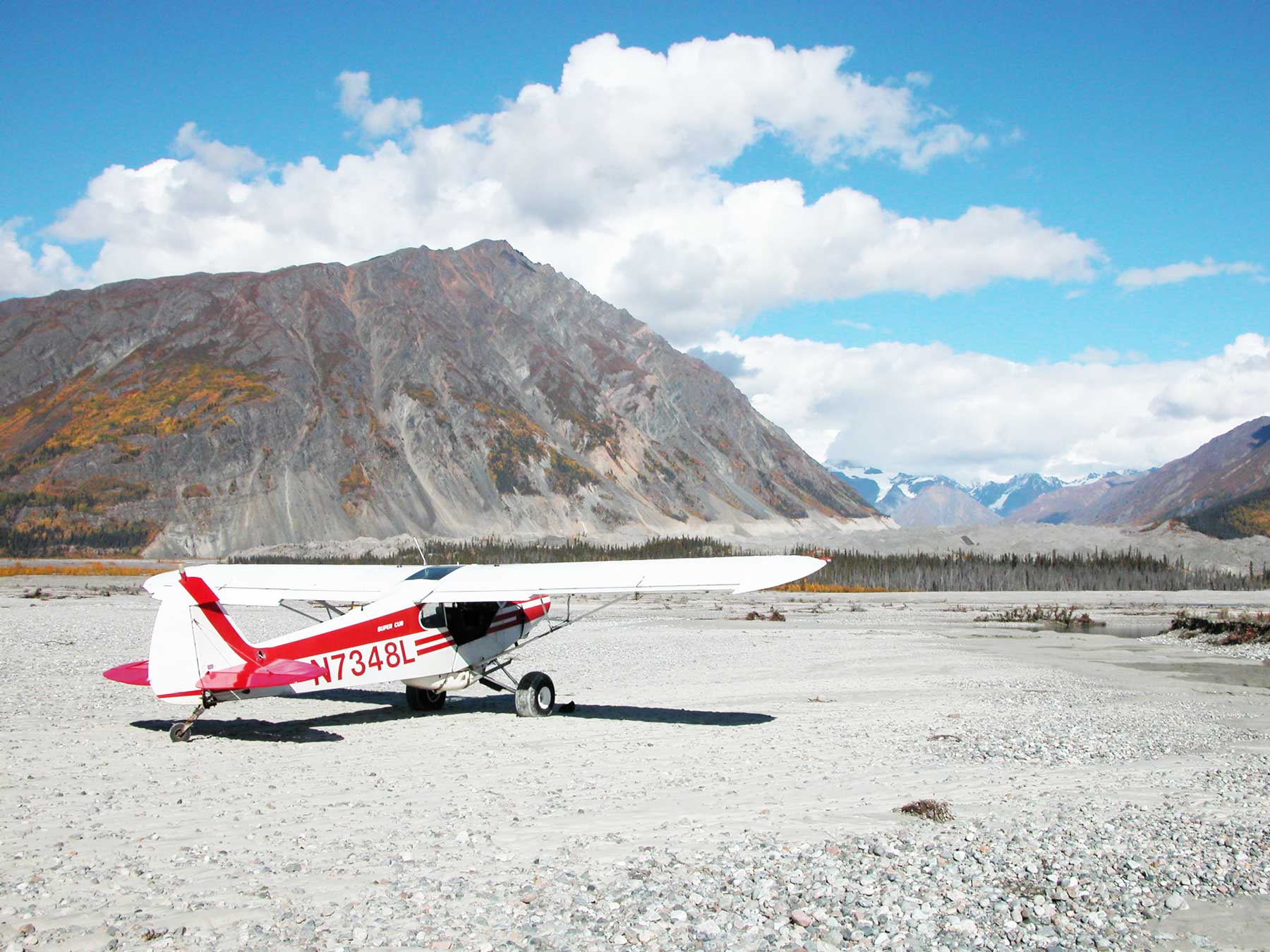
Driving in Wrangell St. Elias National Park
There are two driveable roads in Wrangell St. Elias National Park making it perhaps the most vehicle friendly of all Alaska’s national parks.
However, we recommend a vehicle capable of handling gravel & dirt roads for the trek with at least all-wheel drive (4 wheel-drive is best).
These roads are located 3 hours apart from each other so choosing which one to visit is important.
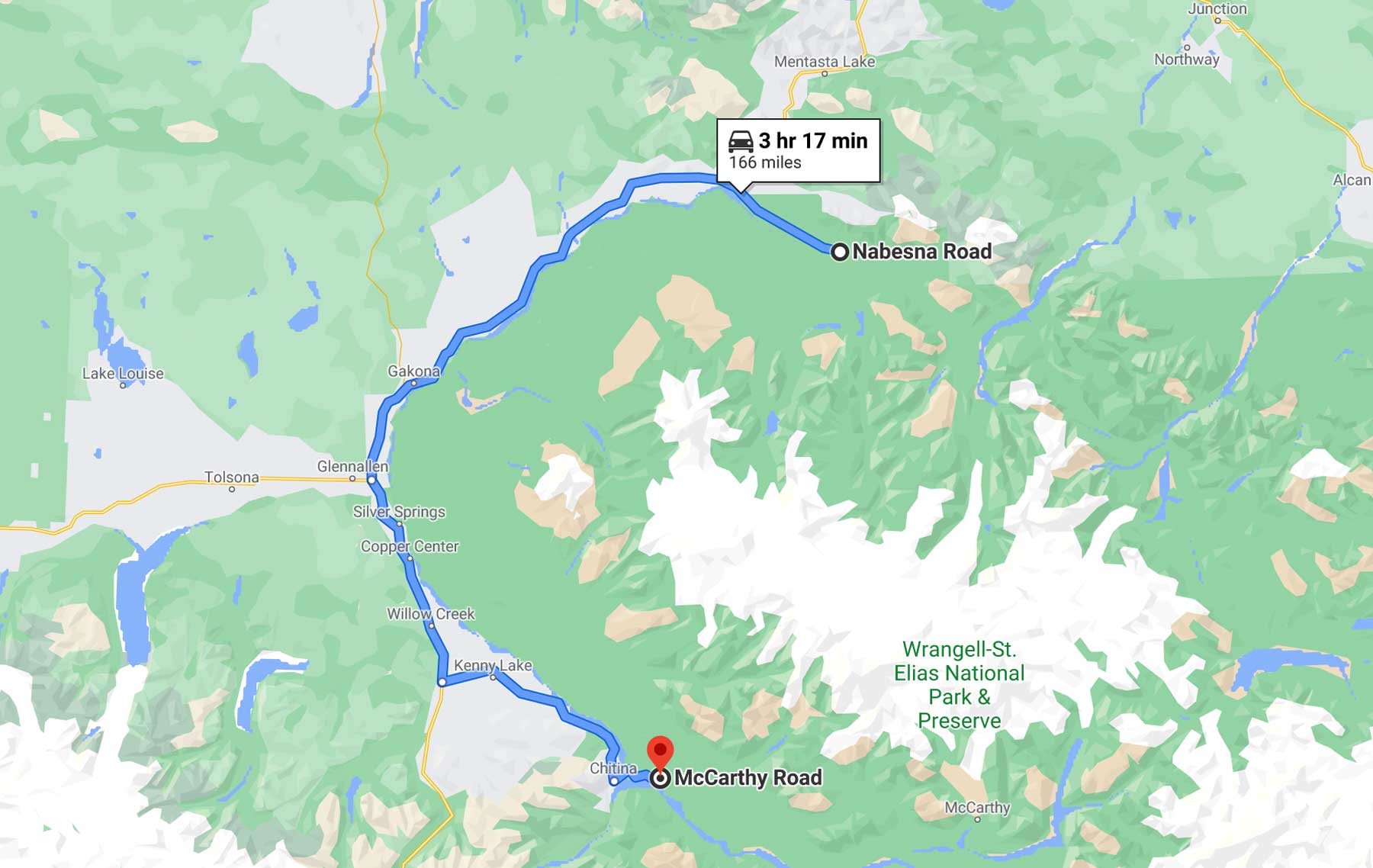
Driving the Nabesna Road
For whatever reason, Nabesna Road does not show up in many guides despite being one of two main access points into the park.
The terminus of Nabesna Road is located next to the Slana Ranger Station, 1.5 hours north of the official Wrangell St. Elias National Park Visitors Center in Copper Center.
The Nabesna Road is a 42 mile long gravel road located within Wrangell St. Elias National Park that features multiple stream crossings.
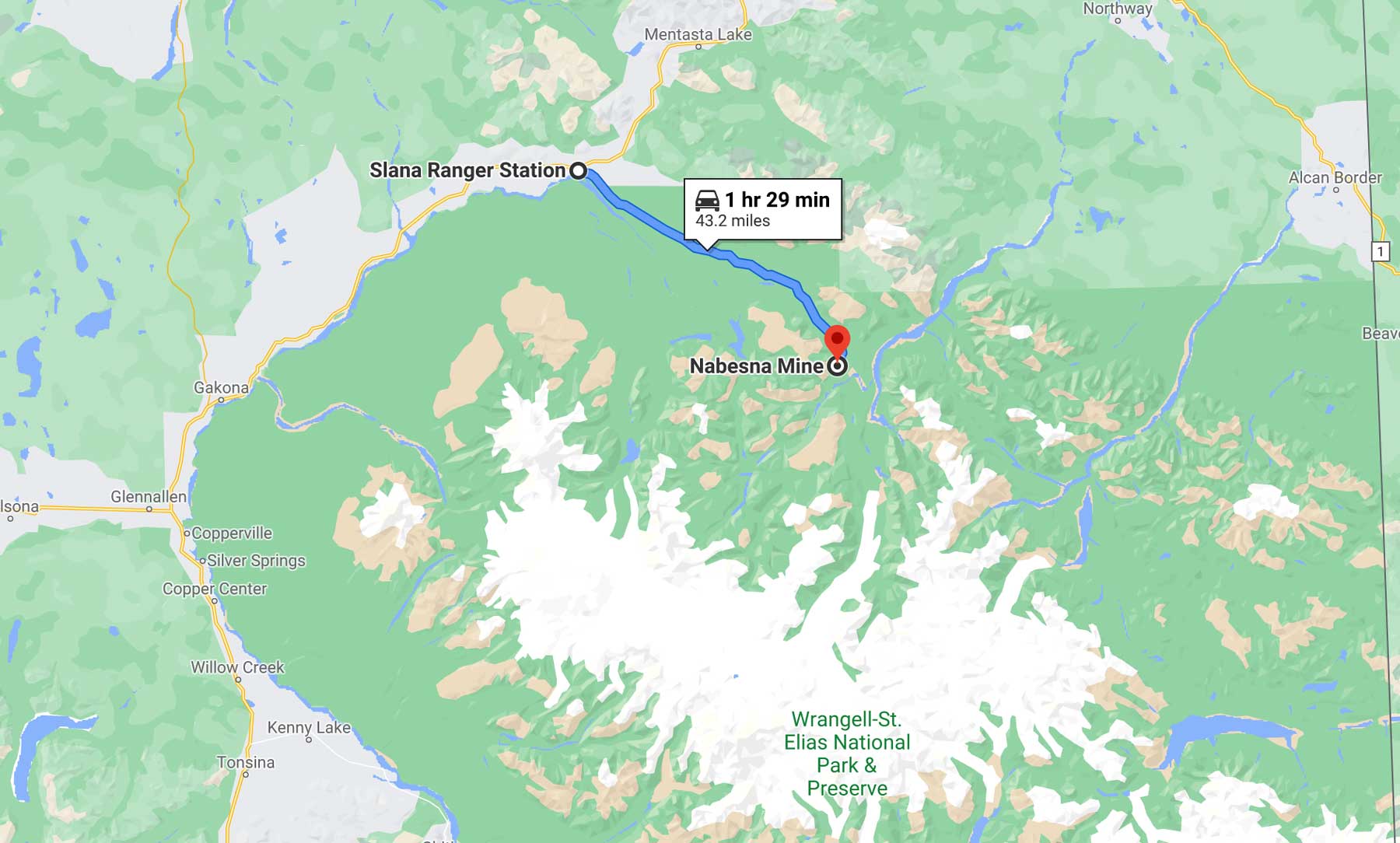
Driving past mile 29 can be especially tricky for non-4WD vehicles due to the stream crossing.
The road requires 1.5 hours to drive minimum each way so keep that in mind when planning a trip. Be sure to bring a spare tire and be prepared to use it.
There are no fuel options on this road so be sure to gas up ahead of time.
Along the road are many trailheads and at least 6 campgrounds/spots (for more on camping see below). For a full road guide check out the park service page.
McCarthy Road (to Kennecot Mine & Root Glacier)
The McCarthy Road is by far the more popular of the two roads open for public use inside of Wrangell St. Elias National Park.
At 60 miles long, the McCarthy Road is gravel and leads to the popular Kennecot Mine and Root Glacier access points.
Driving this road into Alaska’s largest national park takes at least 3 hours each way so plan accordingly.

Be sure your car has a spare tire and that you are prepared to use it as this is one of those kinds of roads.
NOTE: Once you reach the end of the road there are two parking areas and a footbridge that leads into McCarthy. You cannot drive all the way to McCarthy or to the Kennecot mine.
The hike from the footbridge to the Kennecot mine is 5 miles. If you are not up for the hike there is an optional shuttle service on the other side of the footbridge that takes you to the Kennecot mine for about $5.
For more information about the McCarthy Road visit the park service page.
Highlights | Best Things To Do in Wrangell St. Elias Park
- Explore the Historic Kennecot Mine – Many (if not most) of the photos you’ll see of Wrangell St. Elias National Park feature the beautiful and historic Kennecot Mine. Take the shuttle to the mine and soak it in!
- Hike the Root Glacier Trail – Just past the Kennecot Mine is the incredible (and massive) Root Glacier. The trail up to and out on the Glacier is incredibly scenic and not to be missed!
- Drive the McCarthy Road or Nabesna Road – If you’ve got the right (4WD) vehicle we highly recommend a drive down one or both of the park’s roads. Wildlife, camping, scenery, and hiking abound with few other folks.
- Take a Scenic Flight – The absolute best way to make the most of your time and see the park’s grandeur is by air. If you’ve got the budget, flight-seeing in Wrangell is nothing short of epic.
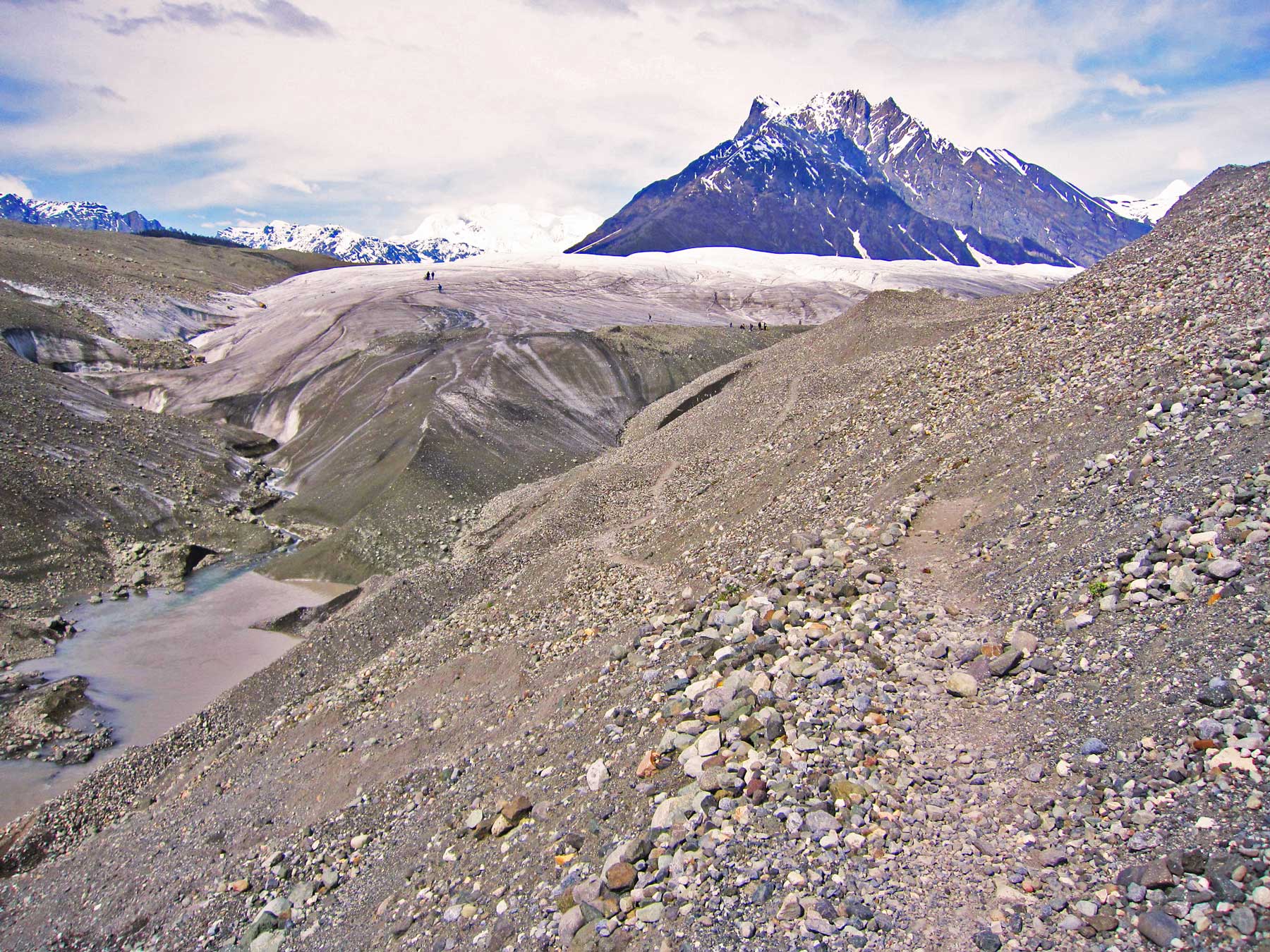
Where to Stay At Wrangell St. Elias National Park
Camping in Wrangell St. Elias
Wrangell St. Elias has a host of camping options mostly concentrated in two areas – McCarthy Road & Nabesna Road.
Along each of these roads are numerous roadside camping areas, some of which have picnic tables and pit or vault toilets. Make sure to practice Leave No Trace and be bear aware in these areas!
There are also a host of backcountry camping options at Wrangell St. Elias National Park. For backcountry camping information be sure to visit the park service backcountry page. There are even backcountry cabins!
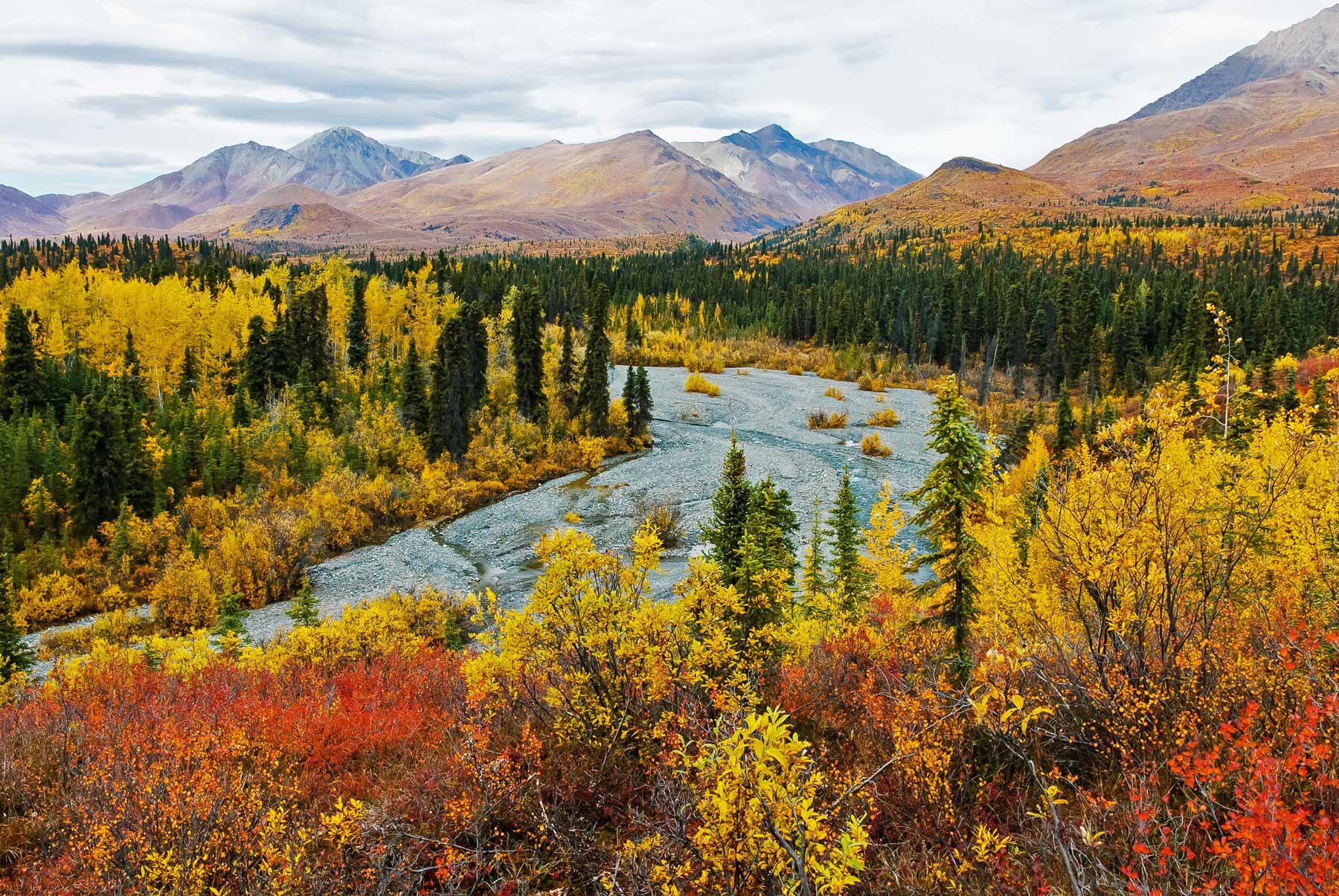
Wrangell St. Elias Hotels & Lodges
We recommend the scenic Kennecot Glacier Lodge located within the park overlooking the Root Glacier. Rates start at $210/night. There are a few other options located in & around McCarthy including:
4. Katmai National Park, Alaska
Score: 35/50
- Accessibility – 1/10
- Recreation – 10/10
- Crowds – 10/10
- Amenities – 4/10
- Scenery – 10/10
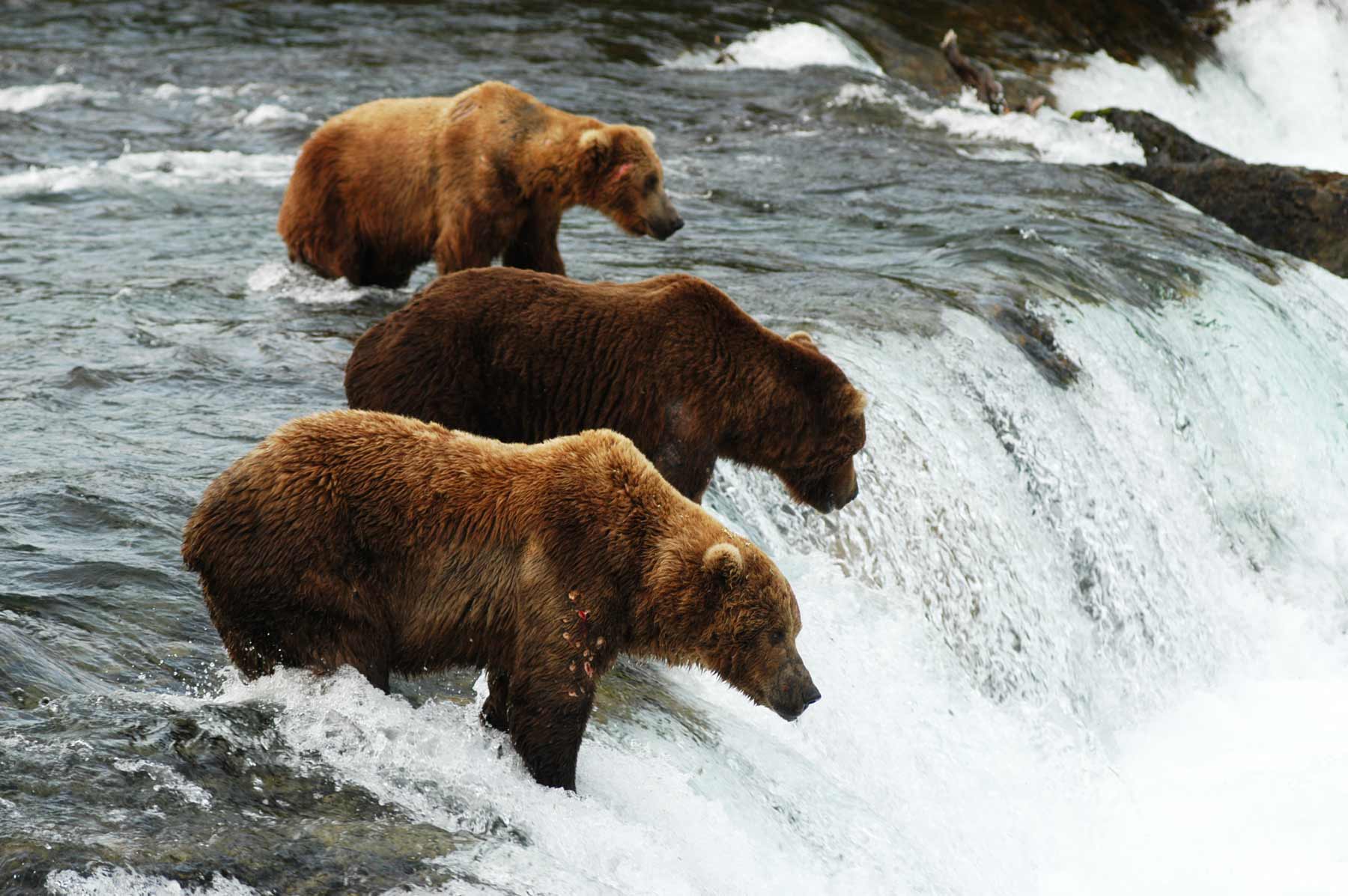
About Katmai National Park
Katmai is one of the most famous Alaska national parks given the amount of social media traffic it gets each summer and fall.
We’ve all seen the famous bearcam of the grizzlies savagely hunting salmon at Brooks Falls, and we all want to see that in person (safely behind the plexiglass viewing area) along with the countless other hard-to-fathom landscapes that exist within this amazing park.
The fact of the matter is that it just ain’t easy (or cheap) to do so. Getting to Katmai typically requires multiple flights and thousands of dollars which puts it squarely out of reach for most Americans.
Getting to Katmai National Park
Accessing Katmai National Park is expensive. There are no roads that lead into the park which means getting to Katmai requires a flight (and not on a commercial flight).
- Small Plane Flight – To get to Katmai one must take a flight to King Salmon or a private charter to another less-traveled destination within the park. Round trip fares from Anchorage to King Salmon, Alaska (the gateway to Katmai) cost between $600 – $700. The flight itself takes about an hour.
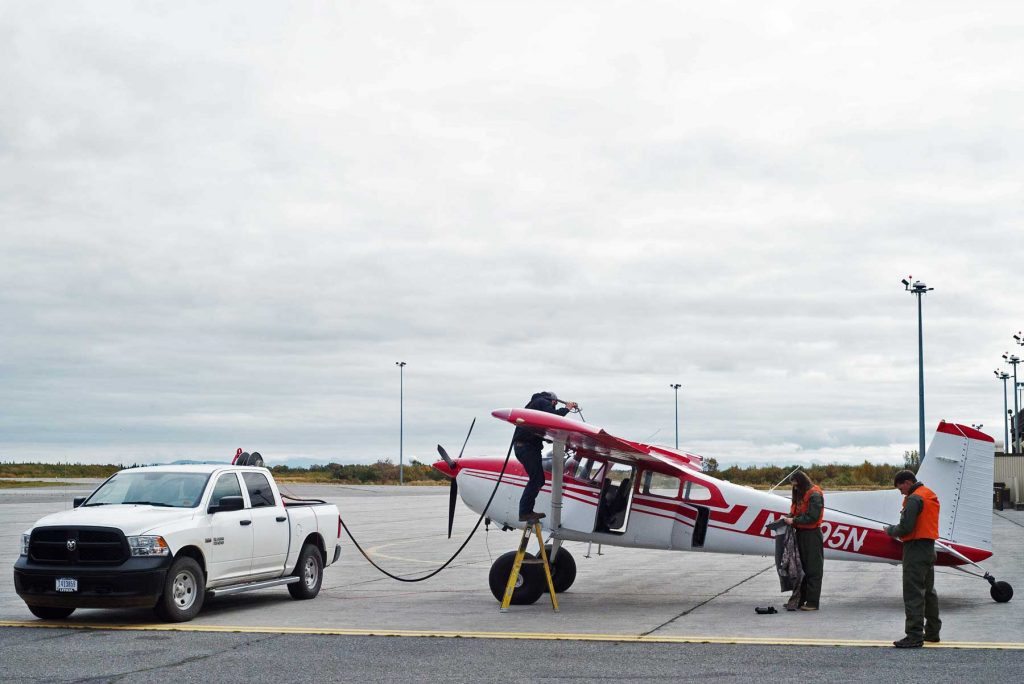
Can You Drive to Katmai National Park?
No, you cannot drive to Katmai National Park. The park is extremely remote located in King Salmon.
Entrance Fees to Katmai National Park
Hooray! There are no entrance fees to Katmai National Park. The cost of getting to the park is high enough I suppose.
Best Time to Visit Katmai National Park – Seasons & Weather
The best time to visit Katmai National Park is during Summer months. We recommend July & August for the best chance of catching some days without rain.
Do expect and plan for rain regardless of the forecast as the overwhelming odds are that you will see rain during your trip and plenty of it.
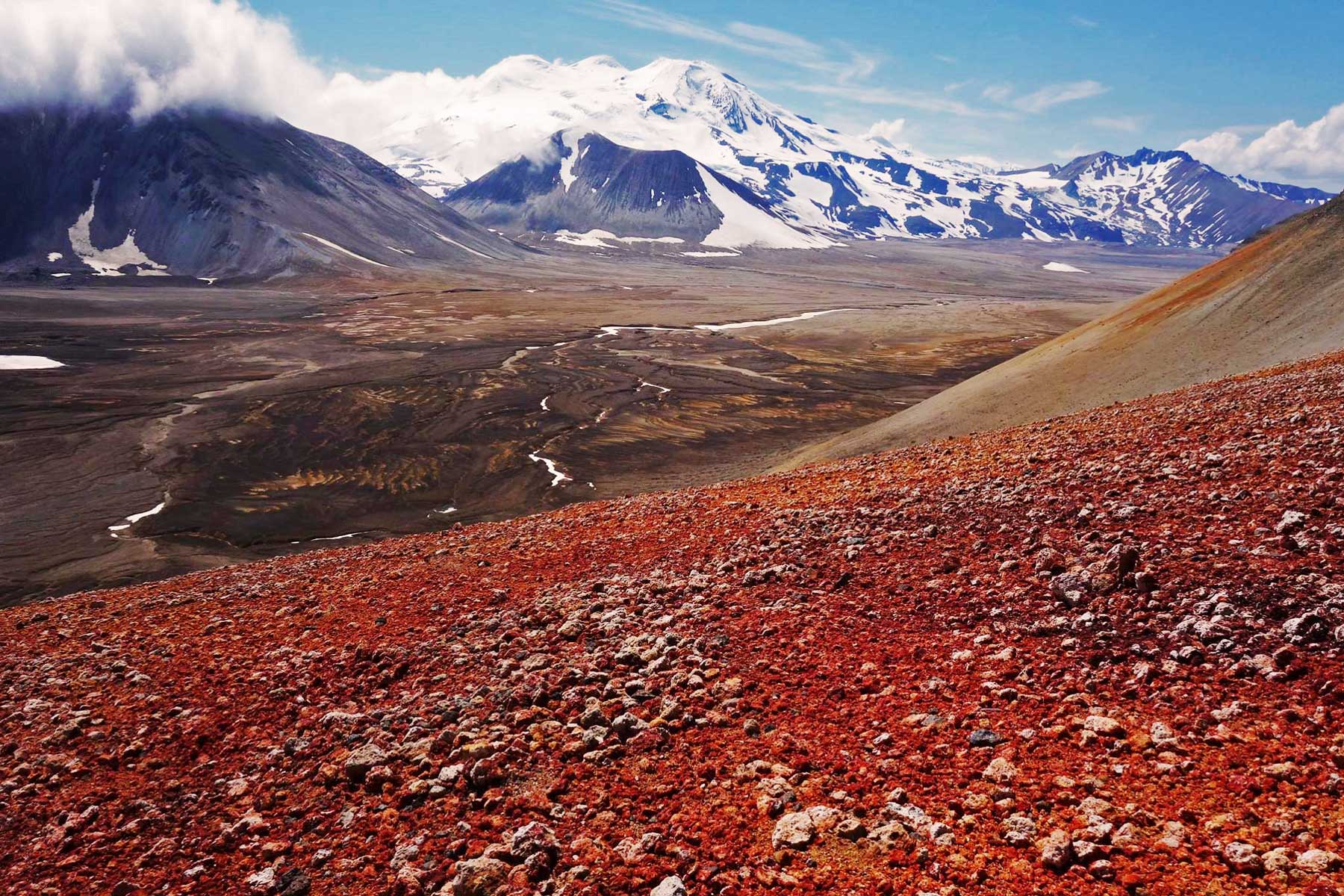
Highlights – Best Things to Do Katmai National Park
- Brooks Falls Bear Watching – The world famous Katmai National Park bear camera resides at Brooks Falls. Getting to Brooks Falls is not cheap requiring yet another non-commercial flight. From King Salmon it the cost to Brooks Falls is around $300. Once here, behold the best bear viewing on the planet via a safe viewing platform.
- Fishing – There is a reason the bears congregate in such numbers at Brooks Falls – world class salmon runs down the Brooks River. This makes for world class fishing opportunities.
- See the Valley of 10,000 Smokes – Katmai National Park is home to some epic volcanic landscapes, perhaps none as famous or breathtaking as the Valley of 10,000 Smokes. From Brooks Camp, bus tours are available to this spectacular valley. The tour costs about $100 round trip with lunch included.
- Flight-Seeing Katmai National Park – The best way to get a grasp of the scale and scope of Katmai National Park’s epic volcanic landscape is via the air. Flight-seeing tours from Brooks run just over $200 per person for an hour of flight time.
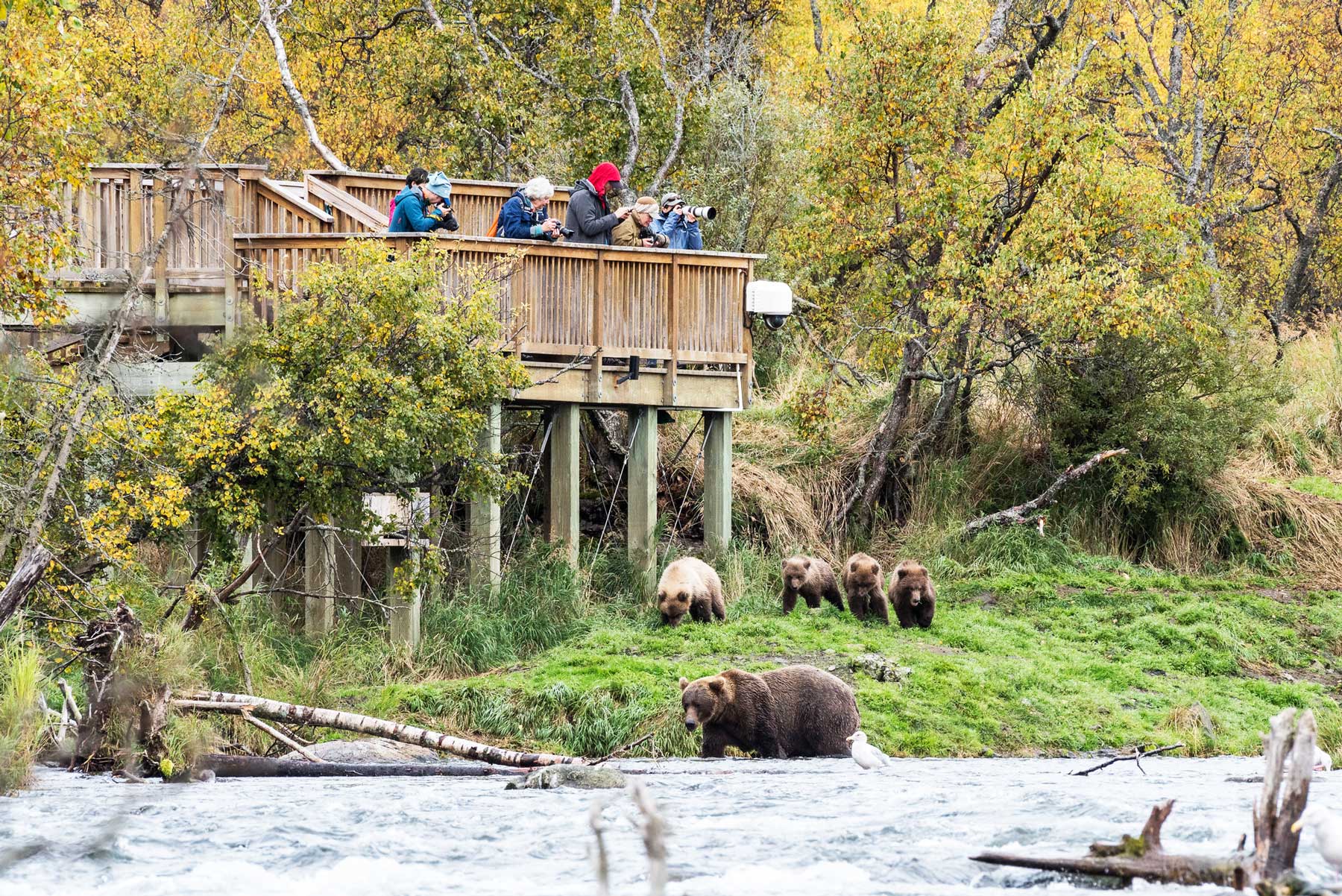
Where to Stay – Katmai National Park Camping & Lodging
Camping in Katmai National Park
Brooks Camp is the sole developed campground at Katmai National Park located near the Brooks Lodge.
Getting to the campground requires a flight on a small plane.
The campground itself has no designated camp sites, rather a 60 person capacity that is filled (rapidly) on a reservation basis via recreation.gov.
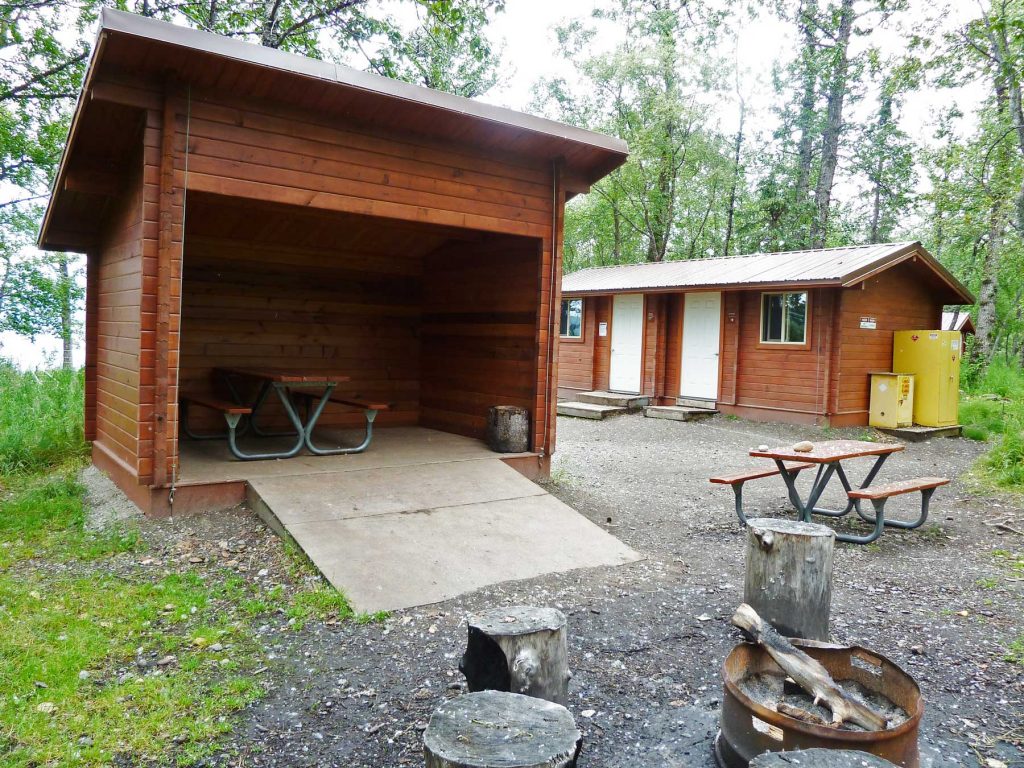
Katmai National Park Hotels & Lodging
We highly recommend the Brooks Lodge located near the famous bear-viewing site, Brooks Falls.
5. Glacier Bay National Park, Alaska
Resources: Map | Guidebook | Facts
Score: 33/50
- Accessibility – 1/10
- Recreation – 9/10
- Crowds – 10/10
- Amenities – 1.5/10
- Scenery – 10/10
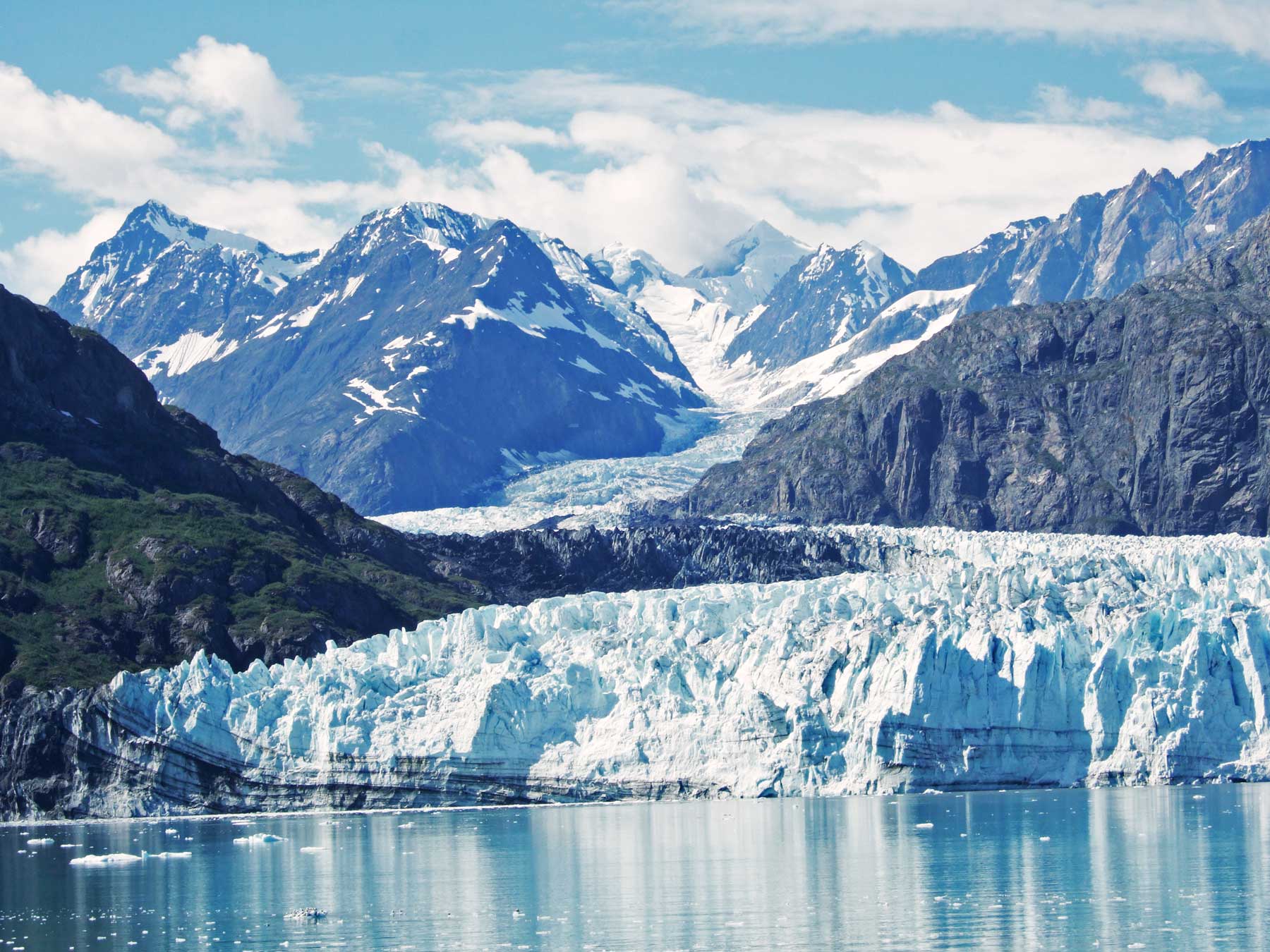
About Glacier Bay National Park
Glacier Bay is a wonderful “cruising park” with spectacular views from the water including orcas, whales, massive glaciers, and so much more.
It’s hard to ask for more breathtaking scenery than what you can find in this Alaska national park. Believe it or not, Glacier Bay is actually Alaska’s most visited national park! So what’s the catch?
Getting to the park is exceedingly difficult unless you’re seeing the park via cruise ship like the vast majority of park visitors. Accessing the park (not via cruise) requires a flight followed by either another flight or ferry.
It also comes with quite a hefty price tag and for that reason it ranks lower on our list despite the incredible sites.
Getting to Glacier Bay National Park
Despite being Alaska’s most-visited national park, Glacier Bay is not one of the most accessible parks.
What gives? Cruise ships make up the majority of this Alaska national park’s visitors. To get to Glacier Bay National Park requires a cruise, ferry, flight, or combination thereof.
- The Alaska Ferry – From Juneau you can take the Alaska Ferry to Gustavas. The price each way is $55 per adult & $33 per child 6 years or older (children 0-5 ride free).
- By Jet – Alaska Airlines flies to Gustavas seasonally during Summer. From Juneau runs around $100 each way and from Anchorage runs between $200 – $300 each way.
- Smaller Plane Flights – Smaller planes fly to Gustavas more regularly and are usually a bit more expensive than Alaska Airlines but not too bad.
- Cruise Ship – Cruise ships are the most popular and least private way to see Glacier Bay National Park.
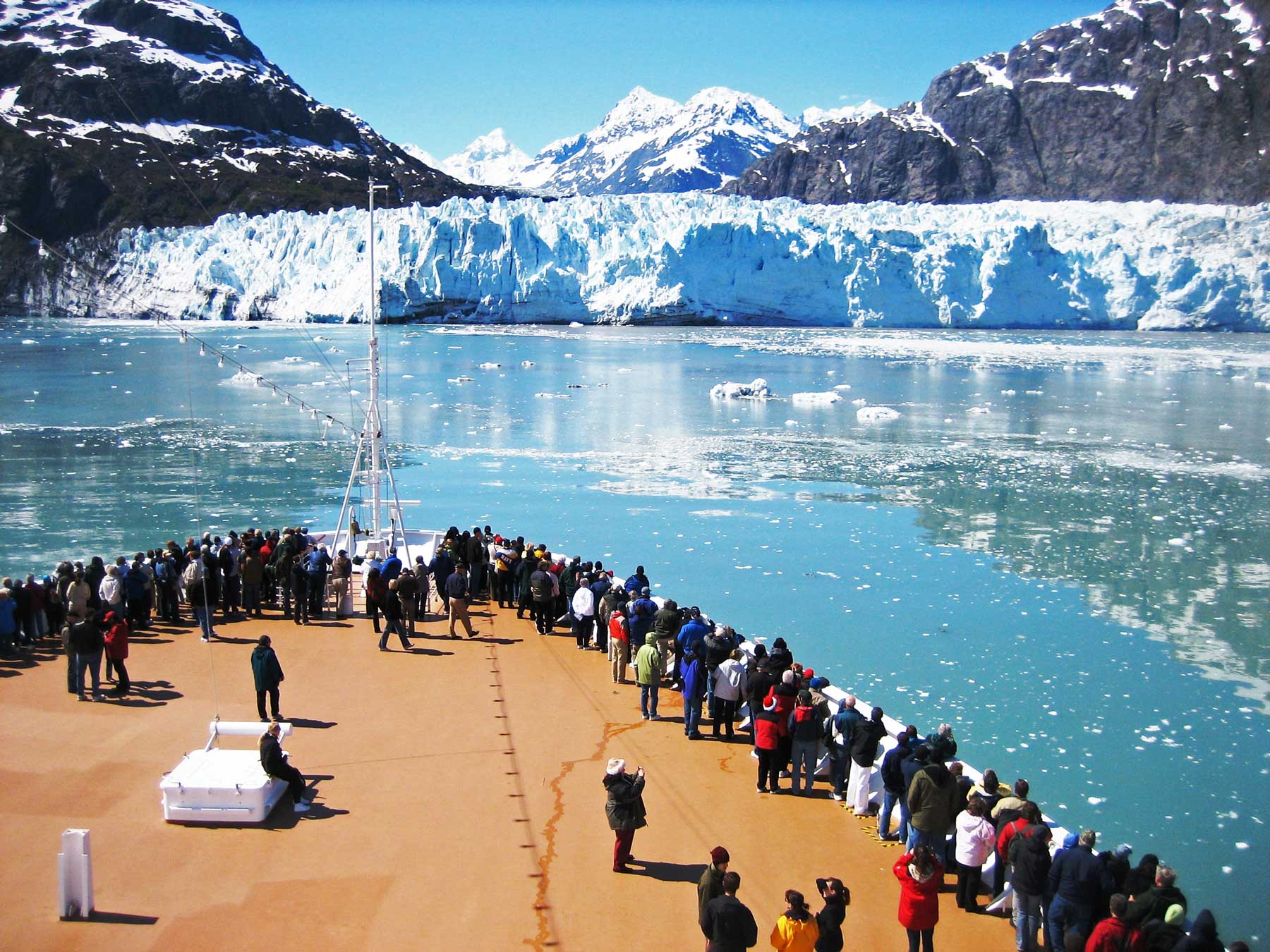
Entrance Fees – Glacier Bay National Park
Great news here folks! Glacier Bay does not charge a fee for admission. So, if you spend the money to get here, crossing the finish line into the park does not require extra wallet-opening.
Can You Drive to Glacier Bay National Park?
If you were hoping to drive to Glacier Bay you’re out of luck. The answer is no, Glacier Bay is not accessible by road and therefore you cannot drive to Glacier Bay.
Best Time to Visit Glacier Bay National Park – Seasons & Weather
The best time to visit Glacier Bay National Park is during Summer months. We recommend July & August for the best chance of catching some days without rain.
Do expect and plan for rain regardless of the forecast as the overwhelming odds are that you will see rain during your trip and plenty of it.
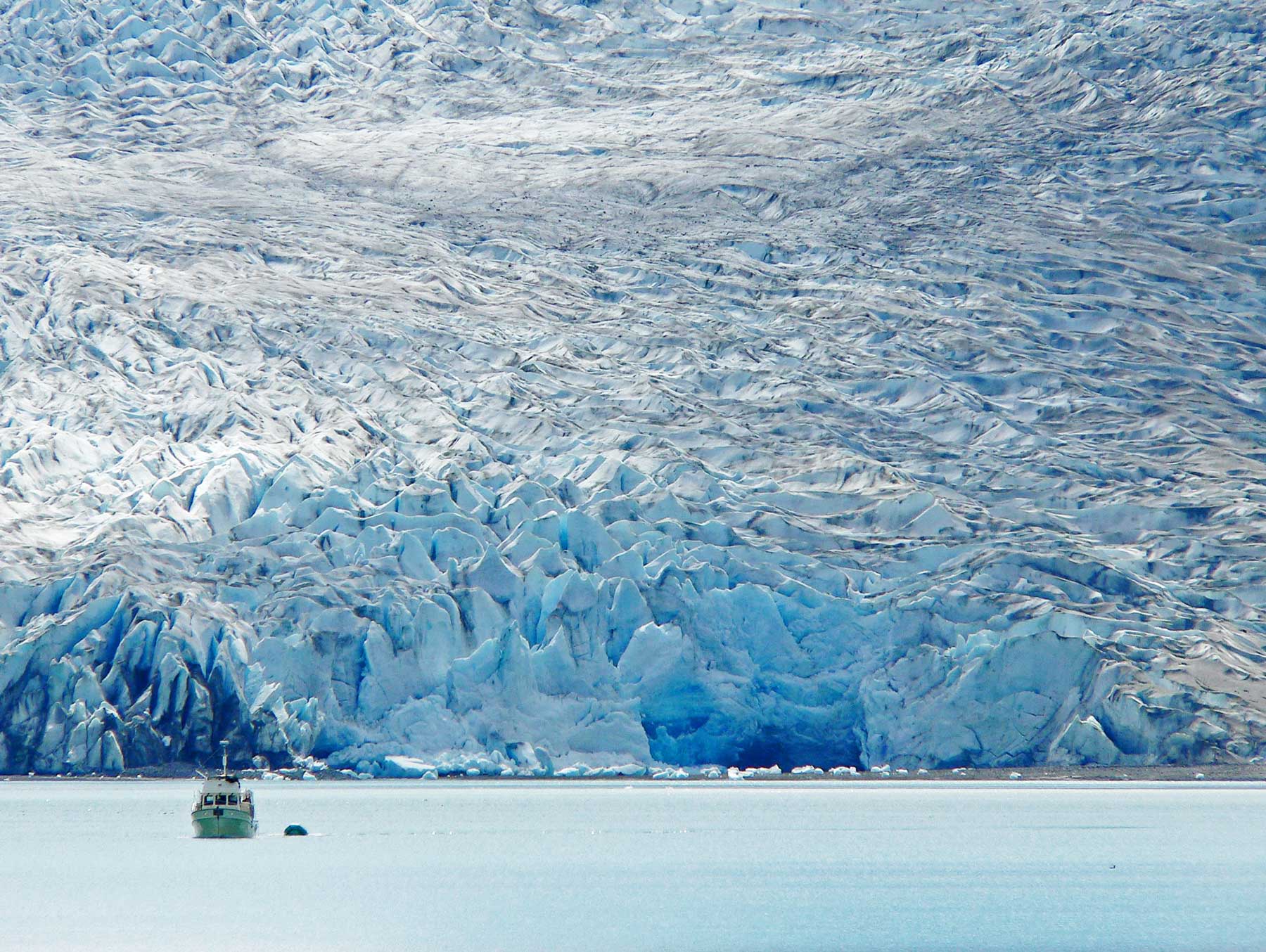
Highlights – Best Things to Do Glacier Bay National Park
- Kayaking – Glacier Bay is home to some world class kayaking near massive glaciers and breathtaking Alaska coastal scenery.
- Boat Tour – The best way to see Alaska’s Glacier Bay National Park is by boat. While the tour can be on the spendier side, if you’ve got the budget it’s definitely worth it!
- Wildlife Viewing – As one of the more remote Alaska national parks, Glacier Bay has splendid wildlife viewing opportunities. Bears, eagles, seals, moose, and whales are among the top highlights here.
- Hiking – Bartlett Cove is the most hiked area of Glacier Bay with several trails with boardwalks along the coast.

Where to Stay – Camping & Lodging at Glacier Bay National Park
Camping in Glacier Bay
There is one developed campground in Glacier Bay National Park and Preserve – Bartlett Cove. Camping here is free but requires visitors picking up a free permit at the ranger station.
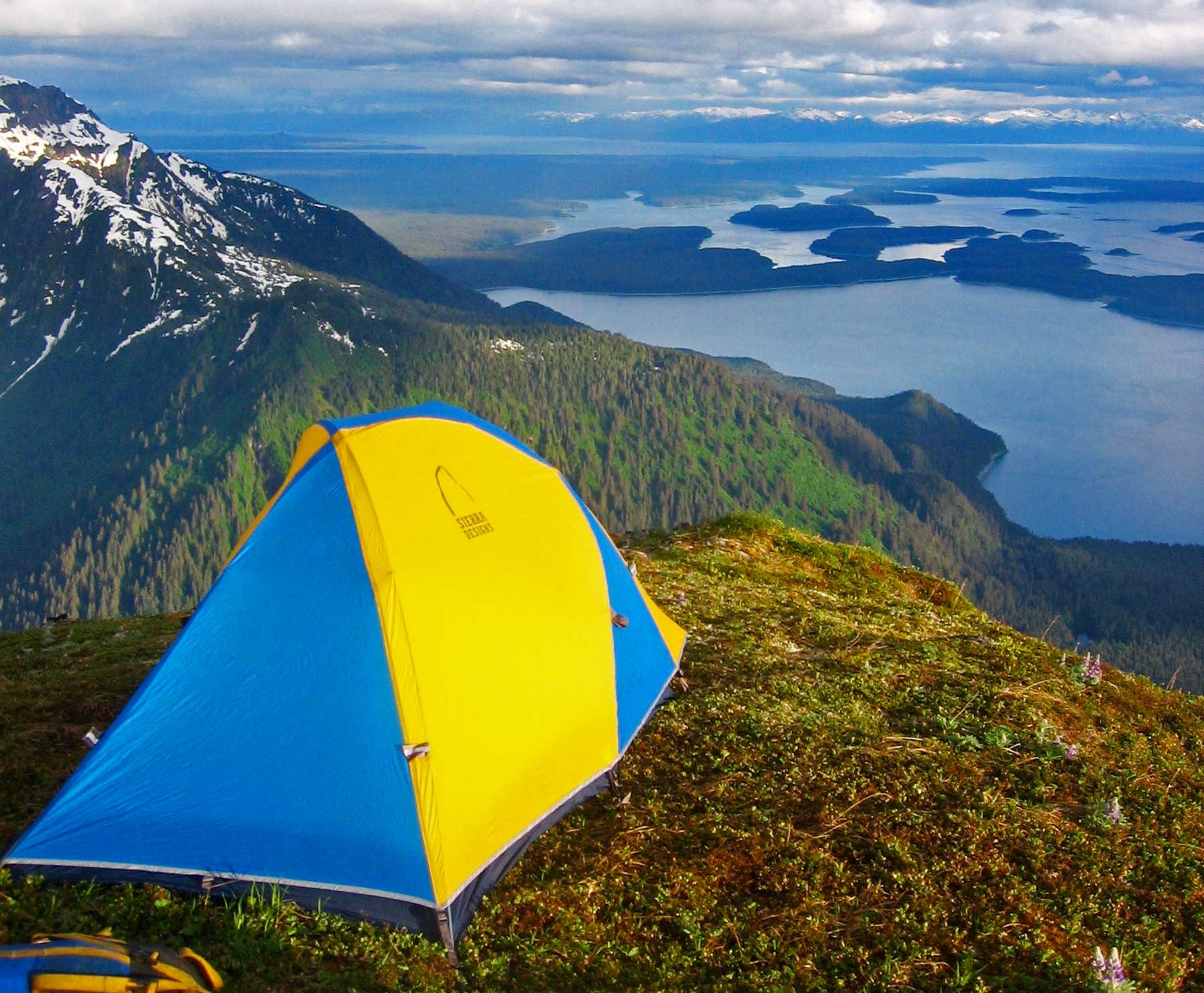
Glacier Bay Backcountry Camping
Backcountry camping is popular at Glacier Bay and primarily done by kayak.
To do this, campers must complete a mandatory backcountry camping orientation and fill out a permit with the park service.
For detailed backcountry camping information visit the parks backcountry camping page.
Glacier Bay National Park Lodges & Hotels
We highly recommend staying at the Glacier Bay Lodge where rooms go for as little as $250/night. Other lodging options in Gustavas include:
6. Lake Clark National Park, Alaska
Resources: Map
Score: 28
- Accessibility – 1/10
- Recreation – 9/10
- Crowds – 10/10
- Amenities – 1.5/10
- Scenery – 10/10

About Lake Clark National Park
Lake Clark is home to some of the most extraordinary landscape scenery on the planet. This Alaska National Park is another one sculpted by glaciers and volcanic activity.
Add in the vast array of wildlife present in the park and you’ve got a real home run.
The only problem, as is the case with most of the Alaska parks, is getting there. Getting to Lake Clark, while not quite as difficult as Gates of the Arctic or Kobuk Valley, is still pretty darn tough. Visitors must take a small plane to reach jumping off points into the park.
The cost for all this? Substantial.
Getting to Lake Clark National Park
Lake Clark is one of the more remote Alaska National Parks which means getting there is logistically challenging.
There are a few options, all of which require a flight on a small plane.
The gateway town to the park is Port Alsworth which can be reached from Anchorage or another one of the small, nearby coastal towns like King Salmon, Homer, or Kodiak.
- Wheeled plane – take a flight on a wheeled plane to snow strips, beaches, and gravel bars.
- Float plane – take a flight on a float plane to Lake Clark or a different body of water.
Two popular flight vendors include Lake Clark Air and Lake and Peninsula Air.
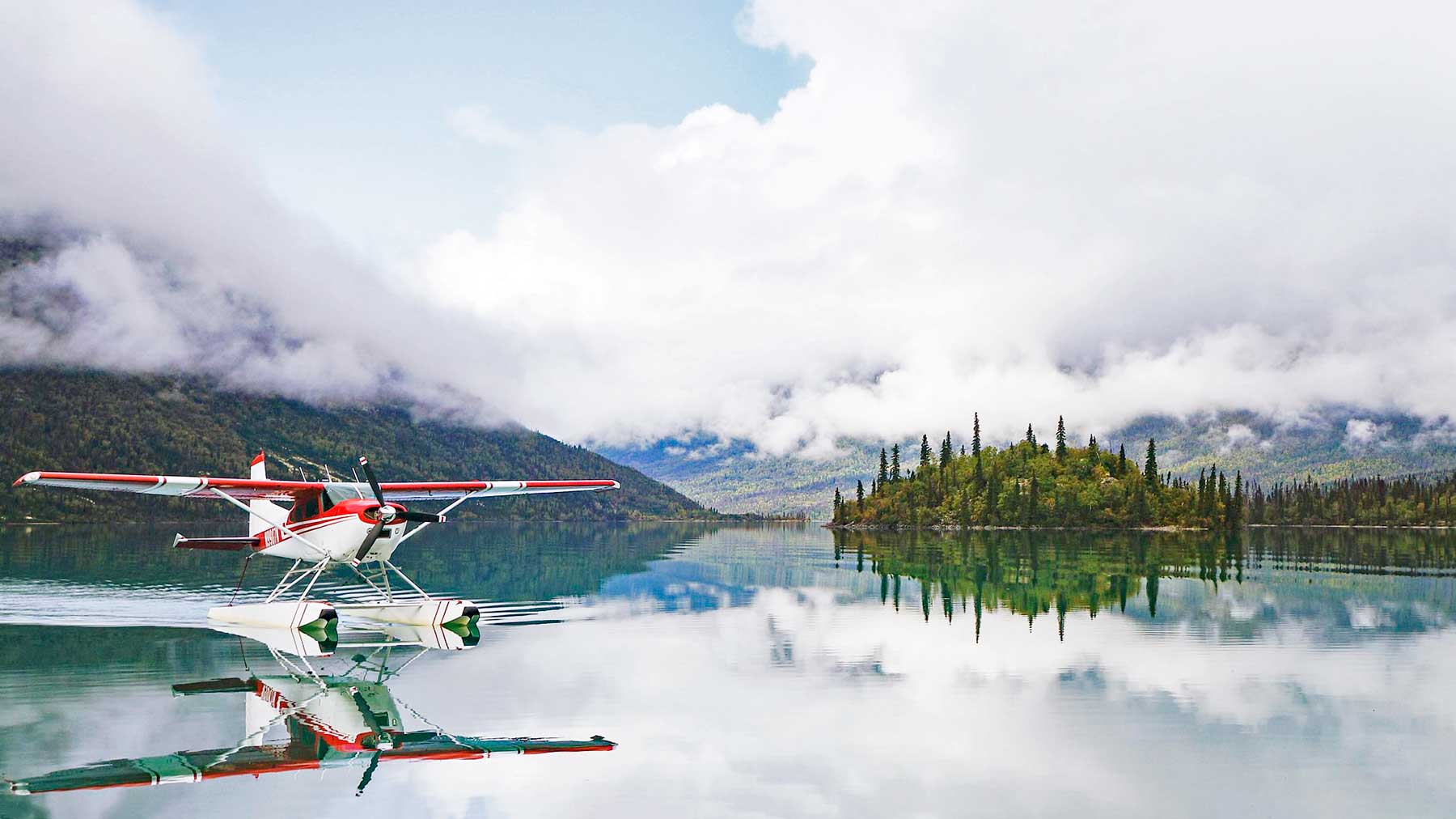
Can You Drive to Lake Clark National Park?
No, you cannot drive to Lake Clark National Park as it is too remote with no roads leading into the park itself. The only way to access the park is by air or water, with flights being the easiest and most popular way.
Entrance Fees – Lake Clark National Park
Good news here, folks! Lake Clark National Park does not charge an admission fee to access the park.
Best Time to Visit Lake Clark National Park – Seasons & Weather
The best time to visit Lake Clark National Park is during Summer months. We recommend July & August for the best chance of catching some days without rain.
Do expect and plan for rain regardless of the forecast as the overwhelming odds are that you will see rain during your trip and plenty of it.
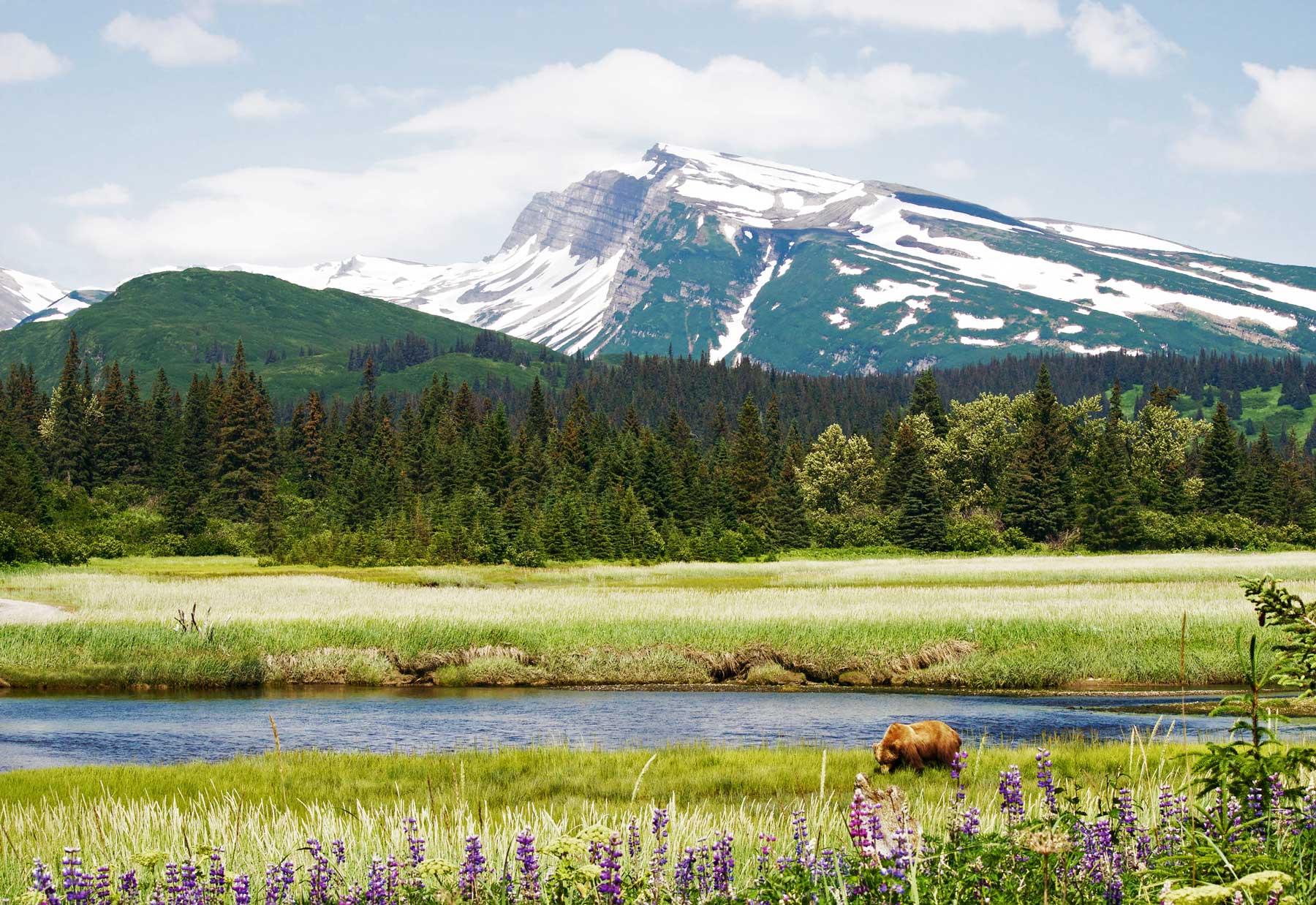
Highlights – Best Things to Do Lake Clark National Park
- Proenneke’s Cabin – Visit this historic cabin featured in a PBS documentary set in the stunning wilderness of Lake Clark National Park.
- Wildlife Viewing – Lake Clark National Park is one of the brown bear viewing capitols of the world not to mention moose, eagles, and all sorts of other spectacular wildlife.
- Canoeing & Kayaking – Lake Clark National Park is home to some of the most breath-taking water activities on the planet. Take a canoe or kayak out onto Lake Clark itself and experience it for yourself.
- Fishing – Wild salmon and beautiful trout are the name of the game in this world-class fishing.
- Day Hikes – Take a scenic hike through beautiful Alaskan scenery from Port Alsworth.
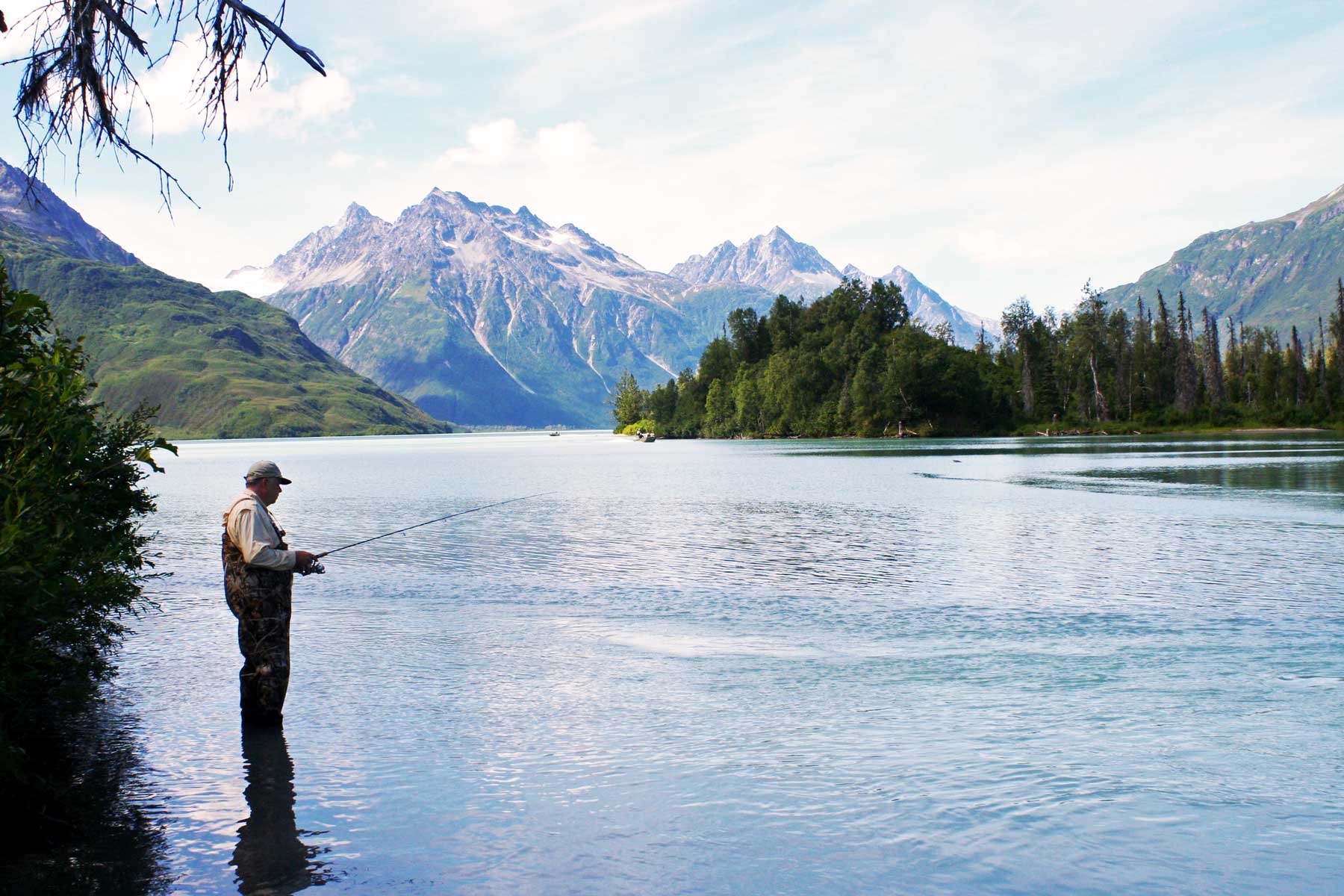
Where to Stay – Camping & Lodging at Lake Clark National Park
Camping at Lake Clark National Park
There are no developed campgrounds or sites in Lake Clark National Park. There is however, an abundance of camping opportunities of the make your own adventure variety.
Lake Clark Backcountry Camping
Backcountry camping & backpacking is the name in Lake Clark National Park as there are no developed campgrounds. For detailed information on backcountry camping guidelines and rules visit the NPS page.
Lake Clark Public Use Cabins
There are a number of reservable public use cabins available in Lake Clark National Park.
- Priest Rock Public Use Cabin
- Joe Thompson Public Use Cabin
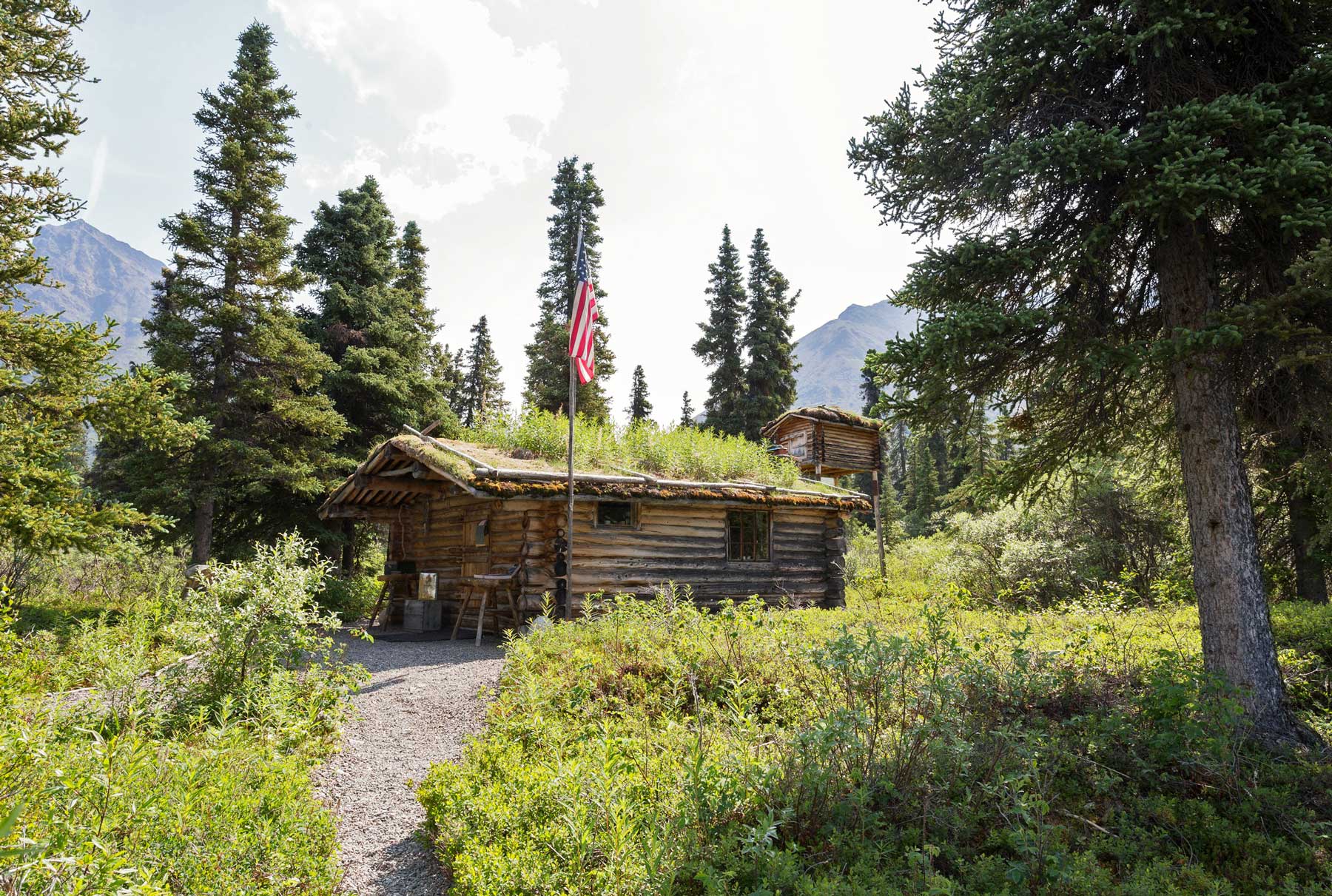
Lake Clark Hotels & Lodges
7. Gates of the Arctic National Park, Alaska
Resources: Map
Score: 28
- Accessibility – 0/10
- Recreation – 8/10
- Crowds – 10/10
- Amenities – 0/10
- Scenery – 10/10
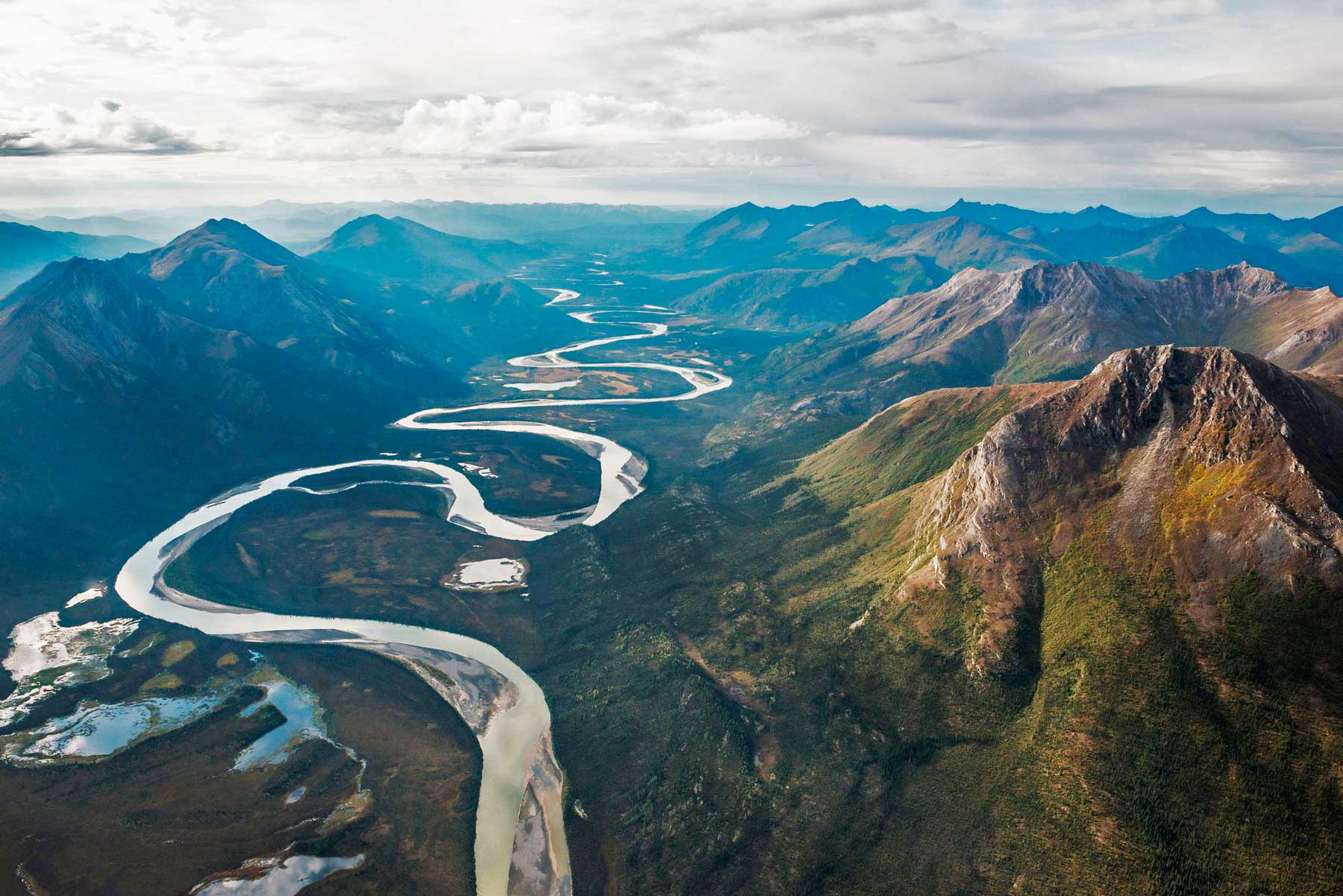
About Gates of the Arctic
Gates of the Arctic is a breathtakingly beautiful place that is nearly impossible for the average person to get to. Getting into the park requires multiple flights, a guide (to do it safely), and thousands of dollars.
It seems to us this park would have been more fitting for a wilderness designation than a national park. For that reason it ranks near the bottom of our list.
With that being said this is one of the most incredible Alaska national parks full of massive mountains and enormous glaciers.
Getting to Gates of the Arctic National Park
Gates of the Arctic National Park is extremely remote and as such requires some work to get there.
The easiest way to get to Gates of the Arctic National Park is to catch a flight from Fairbanks to the small town of Bettles which is an hour or so by flight.
Bettles is the best jumping off point for the park offering guide services and charter flights into the park.
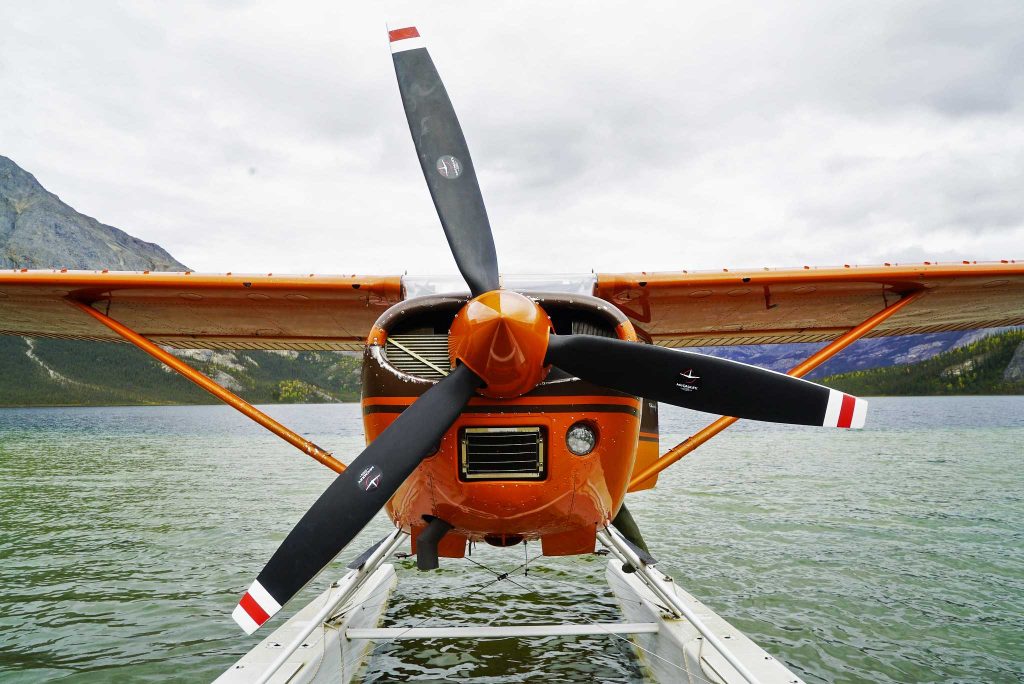
Can You Drive to Gates of the Arctic National Park?
No, you cannot drive to Gates of the Arctic National Park as there are no roads.
Highlights – Best Things to Do Gates of the Arctic National Park
- Wildlife Viewing
- Wilderness Adventures
- Flightseeing
- Backcountry Camping
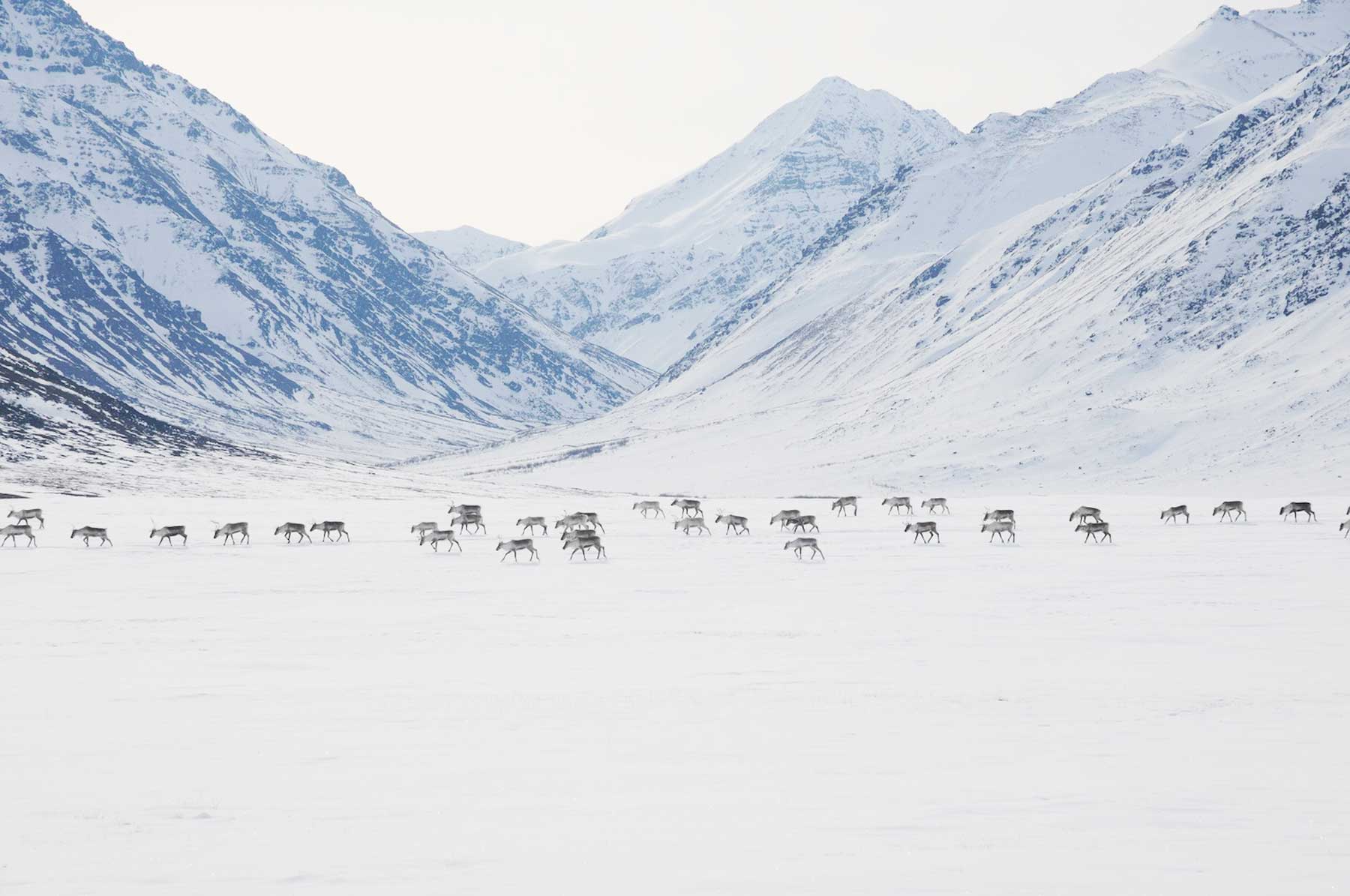
Where to Stay – Camping & Lodging at Gates of the Arctic National Park
If you’re looking for a developed campground or lodge you’ve come to the wrong park, my friend. Gates of the Arctic does not have any developed campgrounds or lodging options other than the ones you create yourself.
Backcountry camping is the only way here.
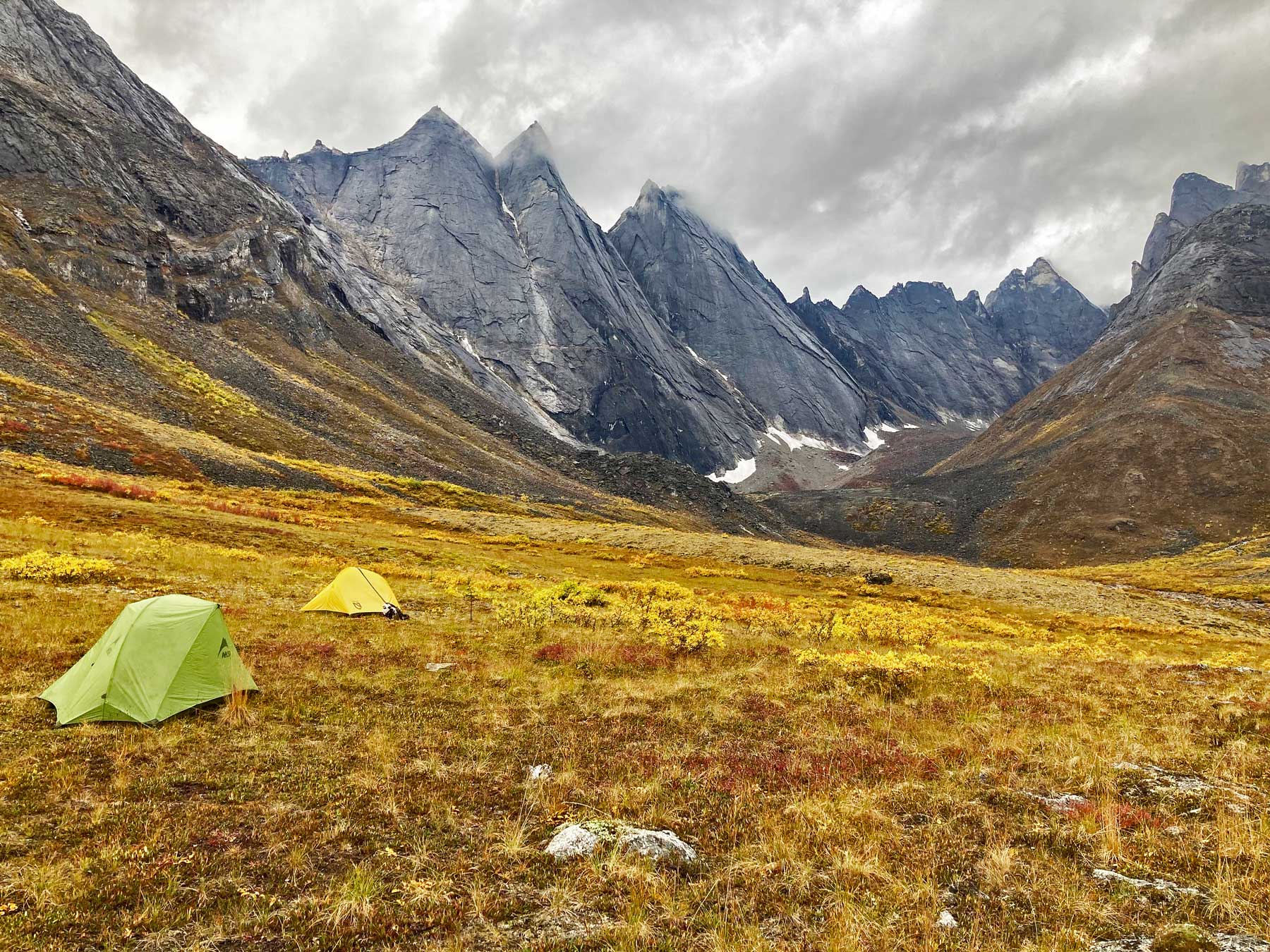
Best Time to Visit Gates of the Arctic National Park
The best time to visit Lake Clark National Park is during Summer months. We recommend July & August for the best chance of catching some days without rain.
Do expect and plan for rain regardless of the forecast as the overwhelming odds are that you will see rain during your trip.

8. Kobuk Valley National Park, Alaska
Score: 27
- Accessibility – 0/10
- Recreation – 7/10
- Crowds – 10/10
- Amenities – 0/10
- Scenery – 10/10
Kobuk Valley is another jaw-droppingly beautiful Alaska national park that is nearly impossible for the average person to access.
An interesting fact about Kobuk Valley is that it’s actually home to massive sand dunes. Bet you didn’t expect to find those so far north in Alaska?
Getting into the park requires multiple flights, a guide (to do it safely), and thousands of dollars.
It seems to us this park would have been more fitting for a wilderness designation than a National Park. For that reason it ranks at the bottom as the official least accessible Alaska National park.
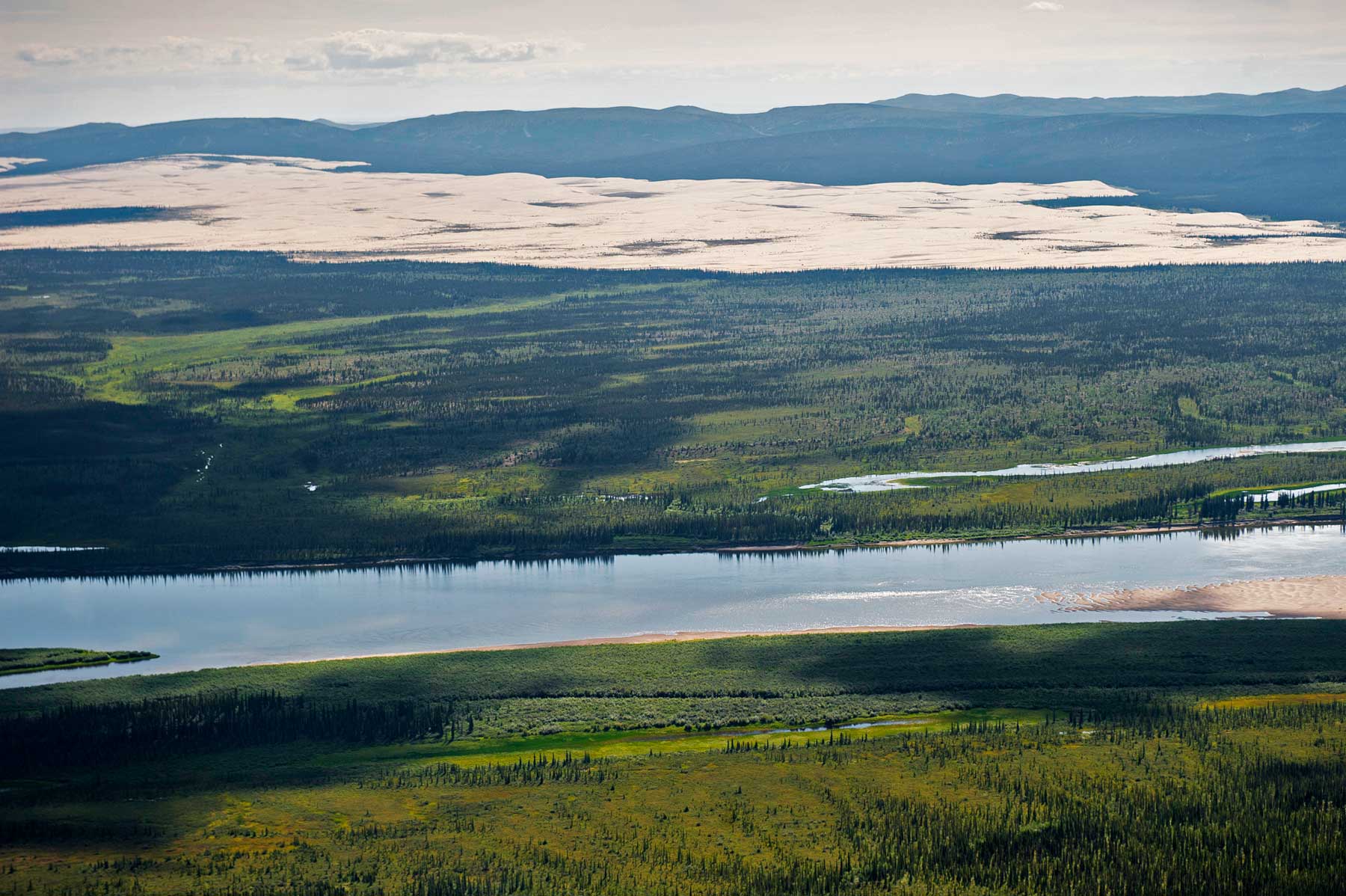
Getting to Kobuk Valley National Park
Kobuk Valley National Park is located north of the Arctic Circle making it the most remote national park in Alaska.
To get there, one must first fly (1 hour 45 minutes from Anchorage) to the extremely isolated town of Kotzebue. From there you can pick up a flight (and guide) into the park.

Entrance Fees to Kobuk Valley National Park
There are no entrance fees to get into Kobuk Valley National Park. Hooray for the pocketbook!
Highlights – Best Things to Do Kobuk Valley National Park
- Kobuk Sand Dunes – You heard that right. Sand dunes in Alaska! The great Kobuk Sand Dunes are a sight to behold and can be accessed via flight.
- Flight Seeing – Charter a scenic flight over this spectacular landscape if you’ve come this far!
- Wildlife Viewing – The best way to spot wildlife in Kobuk Valley is from the air.
- Wilderness Adventures – Plan a guided trip into the Kobuk Valley Wilderness!
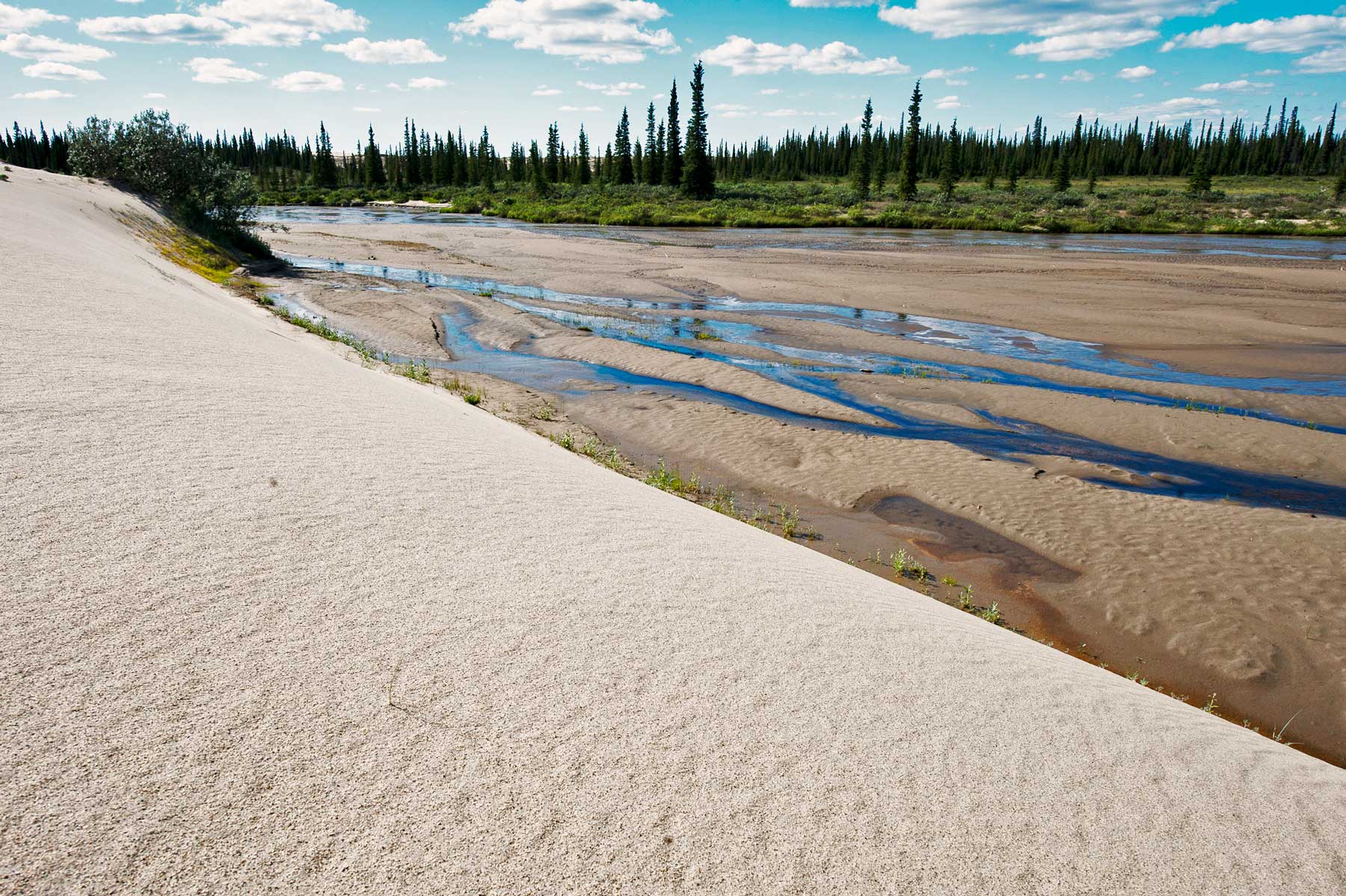
Best Time to Visit Kobuk Valley National Park
The best time to visit Kobuk Valley National Park is during Summer months. We recommend July & August for the best chance of catching some days without rain.
Do expect and plan for rain regardless of the forecast as the overwhelming odds are that you will see rain during your trip.
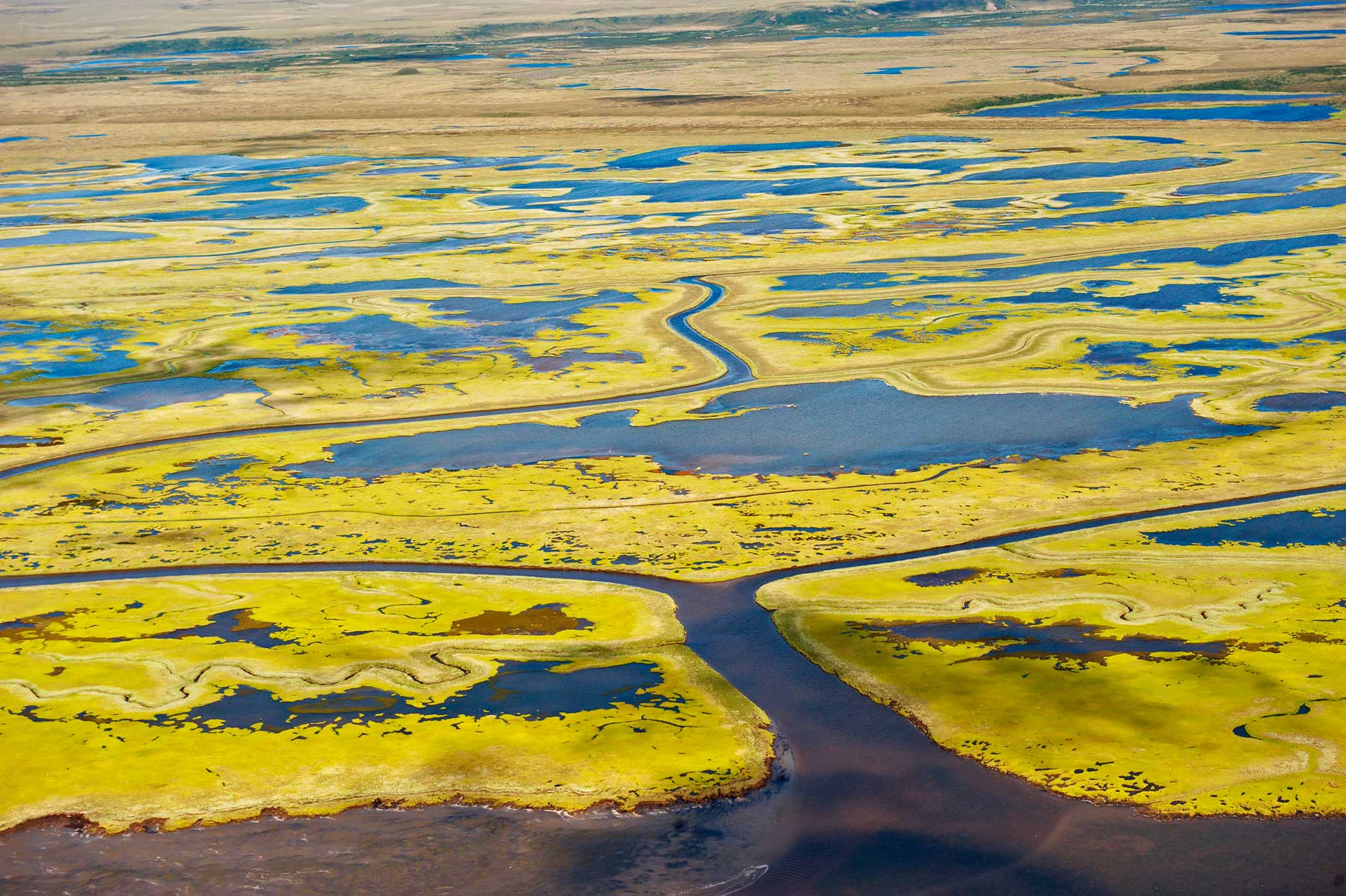
Where to Stay – Camping & Lodging at Kobuk Valley National Park
If you’re looking for a lodge or campground experience, Kobuk Valley is not the place for you. Kobuk Valley National Park doesn’t even have trails, let alone campgrounds or lodges.
Map of Alaska’s National Parks
See below map with the locations of all eight of Alaska’s National Parks. There’s also a downloadable Alaska National Parks map below.
About My Travels to Alaska’s National Parks
You should probably know that I didn’t just make this list up out of thin air.
I’ve spent our entire adult lives exploring and filming America’s national parks and public lands.
We’ve worked with the National Park Service, the Department of Interior, and the U.S. Forest Service for years creating films on important places and issues.
My work (along with my brother) has been featured in leading publications all over the world and even some people outside of our immediate family call us experts on the national parks.
I’m Will Pattiz, and along with my brother, Jim, we’re collectively known as the Pattiz Brothers.
Our goal here at More Than Just Parks is to share the beauty of America’s national parks and public lands through stunning short films in an effort to get Americans and the world to see the true value in land conservation.
We’ve spent a considerable amount of time in Alaska’s National Parks and forests exploring some of the most amazing sights on the planet.
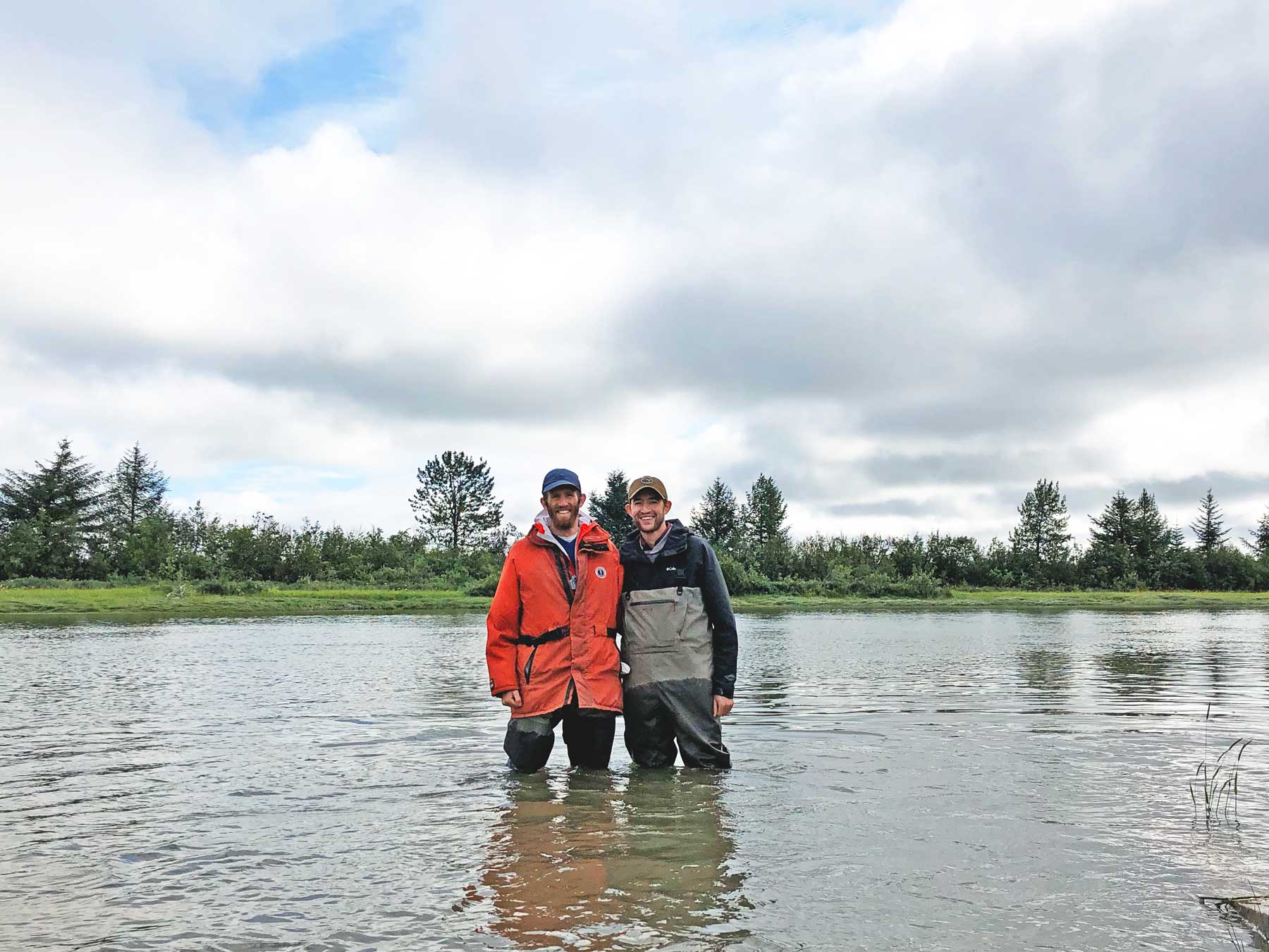
Alaska National Parks Scoring Criteria
I’ve included scores for each Alaska national park just for reference from our post ranking all of the national parks (see below) from best to worst.
These scores do not correlate with the accessibility which is the only criteria we’re using for this list.
The score is a composite of a variety of factors including accessibility, recreational opportunities, crowd sizes, park amenities, and of course, scenic beauty.
Have a look at the breakdown below:
- Accessibility – Is this national park easy to access? We analyzed vehicle access, transportation options, proximity to major airports, lodging and accommodations, conveniences, and other signs of civilization.
- Recreation – Recreation opportunities found in the park like hiking, biking, boating, climbing, etc.
- Crowds – How crowded is this national park? We considered traffic, crowded overlooks & trails, limited campsite availability, lines, etc.
- Amenities – Developed amenities in the park like visitors centers, campgrounds, bathrooms, lodges, etc.
- Scenery – The scenic beauty of the park. Purely subjective of course, but has to be taken into account.
List of Alaska National Parks
- Kenai Fjords National Park
- Denali National Park
- Wrangell St. Elias National Park
- Glacier Bay National Park
- Katmai National Park
- Lake Clark National Park
- Gates of the Arctic National Park
- Kobuk Valley National Park
Leave us a comment about the Alaska National Parks!
That’s a wrap folks! Hopefully you feel a bit more prepared to plan your trip to one or more of Alaska’s national parks.
Please, leave us a comment below and let us know what we’re missing and what you think of the piece!
Pin the Alaska National Parks


Printable Alaska National Parks Map

Download this printable map of Alaska National Parks: JPG
alaska national parks, how many national parks in alaska, largest national park in alaska, alaska national park, alaska national parks, national park alaska, national park of alaska, national parks alaska, national parks in alaska, national parks of alaska, np alaska, alaska parks, best national parks in alaska, best alaska national parks, alaska national parks, how many national parks in alaska, largest national park in alaska, alaska national park, alaska national parks, national park alaska, national park of alaska, national parks alaska, national parks in alaska, national parks of alaska, np alaska, alaska parks, best national parks in alaska, best alaska national parks,
Helpful Related Articles
Alaska National Parks: 8 Amazing Alaska National Parks (Tips for Visiting)
Things to Do in Denali: 20 Best Things to Do in Denali National Park
How Big is Alaska? This is How Big Alaska Is!
Harding Icefield Trail: Hiking the Epic Harding Icefield Trail in Kenai Fjords
Glacier Bay National Park Facts: 11 Amazing Glacier Bay National Park Facts
Denali National Park Facts: 10 Fascinating Facts About Denali National Park
National Parks Ranked: All 63 Best US National Parks Ranked from Best to Worst
National Parks List: Official List of US National Parks (Alphabetical & by State)
National Parks Map: Printable Maps of the National Parks

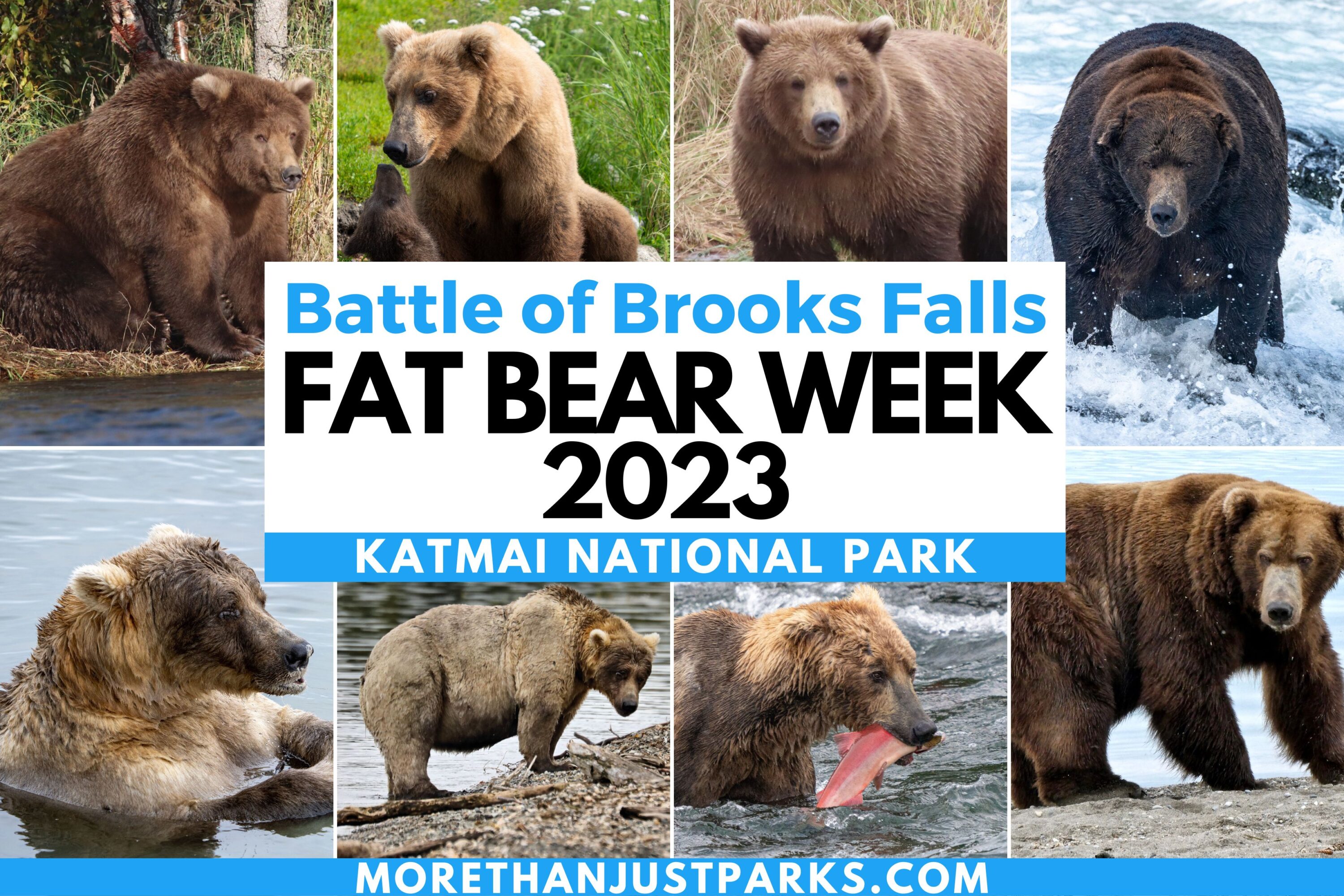
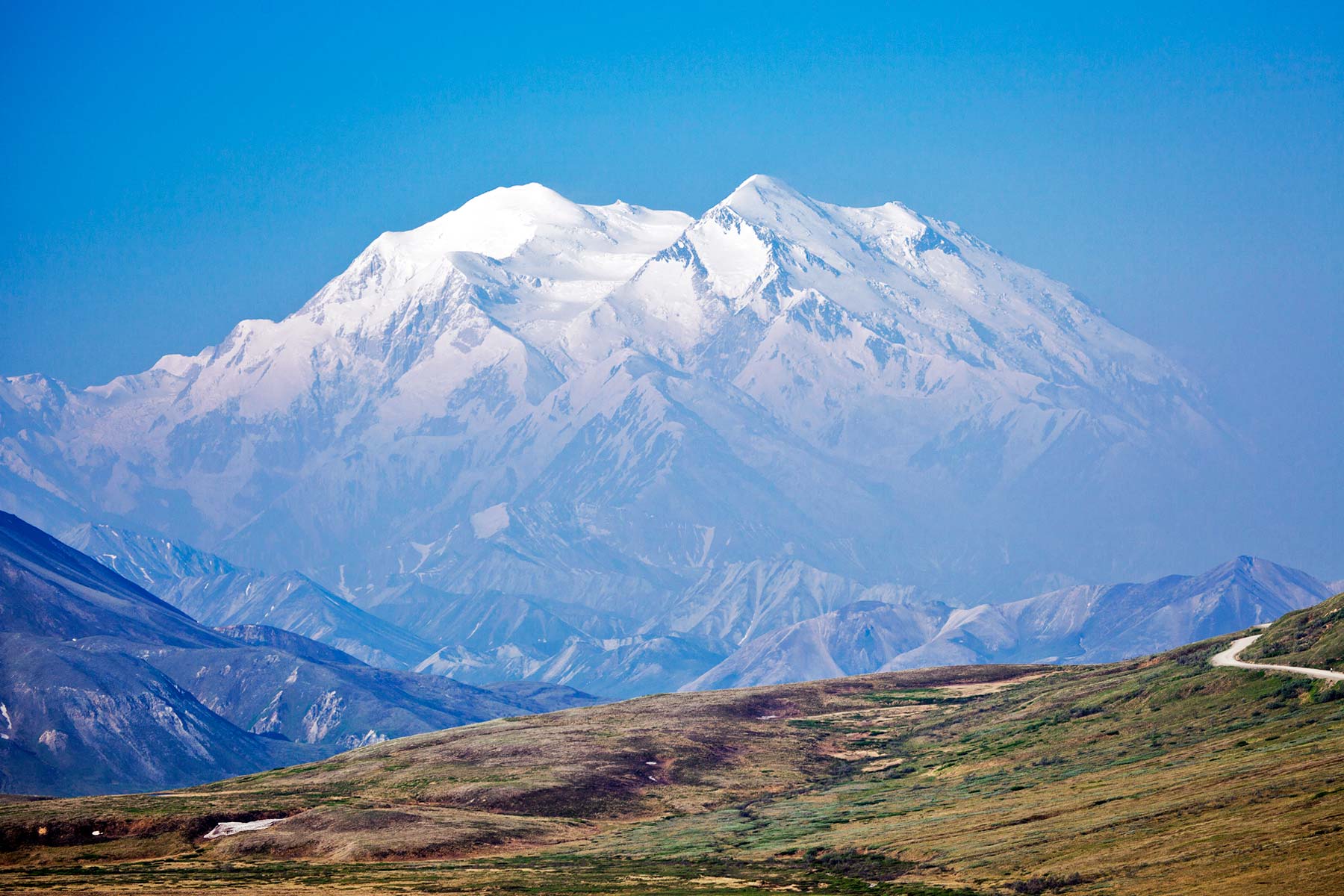
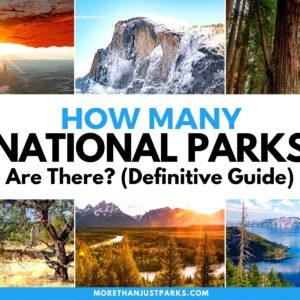

Whenever I read one of your pieces of work, I find myself nodding in agreement 99% of the time. Having seen just over half of America’s national parks, I find your information and opinions spot on. Knowing that, It probably shouldn’t bother me I disagree with the design of your scoring system…… but somehow it does!
I can’t get over each of the 5 scoring categories carry the same weight because I don’t think anybody would agree that they do! SCENERY is 3X more important than any other category when deciding where to visit. I have fussed more than 5 minutes over AMENITIES a grand total of ZERO times when planning a trip. The same thing goes for CROWDS. When suggesting parks to the occasional traveler, I surely warned them about the crowd size, but almost always tell them to “go anyway” Is in places like Zion and Yosemite as the scenery is just that spectacular!
You’ve been using this scoring system for a while now so I should probably just get over it!
Hey John,
Thanks a bunch for stopping in and for the kind words! The ratings system is a work in progress. We’ve got some improvements coming for this year’s rankings starting with our upcoming (and long time in the works) rankings of all 128 national monuments. Should be launching that one next week with the latest ratings system.
We’ve weighted scenery 2X this year. Crowds will still be a factor because in places like Zion, Yosemite, Yellowstone etc it really can hurt the overall experience. I agree it usually doesn’t deter from recommending a place but certainly factors into the decision matrix and hopefully will help with over-tourism and push folks to visit during shoulder seasons etc.
Curious to get your thoughts on the new one once we release!
Best,
Will
Hi guys, thanks for this extremely useful guide. My wife and I are planning our first trip to Alaska this summer and this has helped us in narrowing our to-do list to the more accessible ones for now (while we start planning for the two remote ones by the artic circle next year).
Hi Siddharth!
Thanks for letting us know – so glad to hear it. Alaska is incredible. Keep us posted on how the trip goes!
Happy travels,
Will
Hi guys,
I just organized and finished an Arches to Zion, Grand Canyon North Rim and Antelope Canyon trip for my college classmates’ 40th reunion. We had 42 in the group and we had a blast of a time. The down side is that now they keep bugging me for the next adventure.
Alaska National Parks is what I have in mind and your article is a great first step in the planning process. Still, it seems daunting compared to the A2Z trip. Do you know of a travel agent to help with the plan. I am thinking August 2024 timeframe.
Thanks.
My husband & I made a life goal to visit all the National Parks over 25 years ago. I’m very proud to share that we only have 2 remaining, Pinnacles in CA & Kobuk Valley in AK. Alaska is absolutely my “Happy Place”.
I wanted to add that there is a wonderful remote lodge located north of the Arctic Circle, just outside of Gates of the Arctic NP. We first visited in Aug 2014 & then went back in March of 2019 to try dogsledding, which was amazing. Check out their website. The name of the lodge is Iniakuk Lake Wilderness Lodge, & it was built by hand in 1974 (before Gates of the Arctic NP was established). It is still owned & operated by the same family. Their website is go far north.com This is an all inclusive wilderness resort & well worth the expense, but like their website states, it’s certainly not for everyone. John does an excellent job keeping everything running smoothly.
Aug/Sept 2021 two friends and I did a 3 week road trip in Alaska. We made it to all but one (Kobuk Valley) National Parks. Fog and rain prevented us from flying into the canyon in to reach Kobuk. Amazing adventure. My one friend went back this year to bag Kobuk but weather again prevented her from landing but at least got a fly over.
It feels like it is a crime to not have all the Alaskan parks having a 10 in scenery.